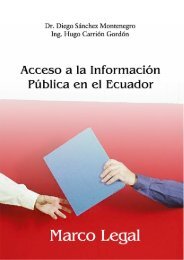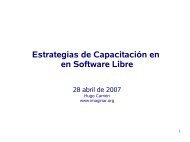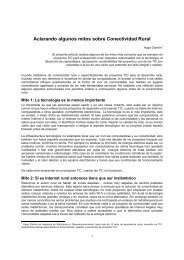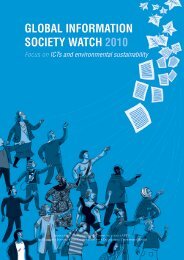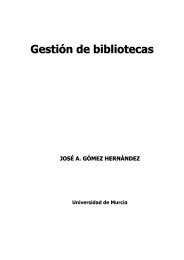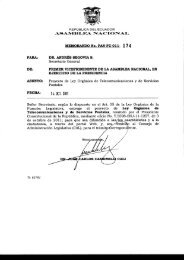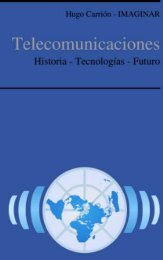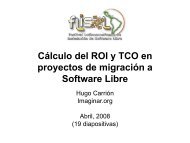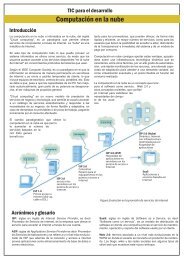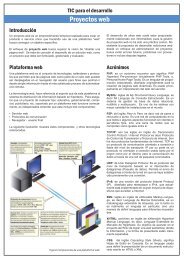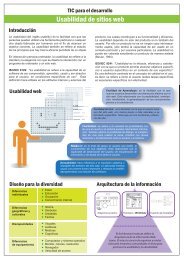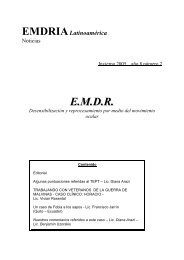The State of the Art and Practice in Digital Preservation - CiteSeer
The State of the Art and Practice in Digital Preservation - CiteSeer
The State of the Art and Practice in Digital Preservation - CiteSeer
You also want an ePaper? Increase the reach of your titles
YUMPU automatically turns print PDFs into web optimized ePapers that Google loves.
Volume 107, Number 1, January–February 2002<br />
Journal <strong>of</strong> Research <strong>of</strong> <strong>the</strong> National Institute <strong>of</strong> St<strong>and</strong>ards <strong>and</strong> Technology<br />
[J. Res. Natl. Inst. St<strong>and</strong>. Technol. 107, 93–106 (2002)]<br />
<strong>The</strong> <strong>State</strong> <strong>of</strong> <strong>the</strong> <strong>Art</strong> <strong>and</strong> <strong>Practice</strong> <strong>in</strong><br />
<strong>Digital</strong> <strong>Preservation</strong><br />
Volume 107 Number 1 January–February 2002<br />
Kyong-Ho Lee, Oliver Slattery,<br />
Richang Lu, Xiao Tang, <strong>and</strong><br />
Victor McCrary<br />
National Institute <strong>of</strong> St<strong>and</strong>ards <strong>and</strong><br />
Technology,<br />
Gai<strong>the</strong>rsburg, MD 20899-8951<br />
kyong-ho.lee@nist.gov<br />
oliver.slattery@nist.gov<br />
richang.lu@nist.gov<br />
xiao.tang@nist.gov<br />
victor.mccrary@nist.gov<br />
1. Introduction<br />
Information preservation is one <strong>of</strong> <strong>the</strong> most important<br />
issues <strong>in</strong> human history, culture, <strong>and</strong> economics, as well<br />
as <strong>the</strong> development <strong>of</strong> our civilization. While earliest<br />
<strong>in</strong>formation was recorded <strong>in</strong> carv<strong>in</strong>gs on stone, ceramic,<br />
bamboo, or wood, <strong>the</strong> development <strong>of</strong> civilization paved<br />
<strong>the</strong> way for new storage media <strong>and</strong> techniques for<br />
record<strong>in</strong>g <strong>in</strong>formation, such as writ<strong>in</strong>g on silk or pr<strong>in</strong>t<strong>in</strong>g<br />
on paper. Eventually we were able to put photographic<br />
images on film <strong>and</strong> music on records. A revolutionary<br />
change occurred <strong>in</strong> <strong>the</strong> <strong>in</strong>formation storage field<br />
with <strong>the</strong> <strong>in</strong>vention <strong>of</strong> electronic storage media.<br />
With <strong>the</strong> advent <strong>of</strong> high-performance comput<strong>in</strong>g <strong>and</strong><br />
high-speed networks, <strong>the</strong> use <strong>of</strong> digital technologies is<br />
<strong>in</strong>creas<strong>in</strong>g rapidly. <strong>Digital</strong> technologies enable <strong>in</strong>formation<br />
to be created, manipulated, dissem<strong>in</strong>ated, located,<br />
<strong>and</strong> stored with <strong>in</strong>creas<strong>in</strong>g ease. Ensur<strong>in</strong>g long-term<br />
access to <strong>the</strong> digitally stored <strong>in</strong>formation poses a significant<br />
challenge, <strong>and</strong> is <strong>in</strong>creas<strong>in</strong>gly recognized as an<br />
important part <strong>of</strong> digital data management [1,2].<br />
<strong>The</strong> goal <strong>of</strong> digital preservation is to<br />
ensure long-term access to digitally<br />
stored <strong>in</strong>formation. In this paper, we<br />
present a survey <strong>of</strong> techniques used <strong>in</strong><br />
digital preservation. We also <strong>in</strong>troduce<br />
representative digital preservation projects<br />
<strong>and</strong> case studies that provide <strong>in</strong>sight <strong>in</strong>to<br />
<strong>the</strong> advantages <strong>and</strong> disadvantages <strong>of</strong><br />
different preservation strategies. F<strong>in</strong>ally, <strong>the</strong><br />
pros <strong>and</strong> cons <strong>of</strong> current strategies,<br />
critical issues for digital preservation, <strong>and</strong><br />
future directions are discussed.<br />
93<br />
Key words: digital preservation; emulation;<br />
encapsulation; migration; st<strong>and</strong>ardization;<br />
XML.<br />
Accepted: November 29, 2001<br />
Available onl<strong>in</strong>e: http://www.nist.gov/jres<br />
<strong>The</strong> evolution <strong>of</strong> data storage media <strong>and</strong> <strong>the</strong> development<br />
<strong>of</strong> <strong>the</strong> preservation technology can be described as<br />
shown <strong>in</strong> Fig. 1. This diagram lists <strong>the</strong> various media<br />
used <strong>in</strong> data storage (both digital <strong>and</strong> analog) <strong>and</strong> <strong>the</strong><br />
techniques needed to ensure that <strong>the</strong> data on <strong>the</strong>m is<br />
preserved. It also highlights <strong>the</strong> trend from analog to<br />
digital/optical storage media <strong>and</strong> <strong>in</strong>dicates <strong>the</strong> transfer<br />
<strong>of</strong> data from one generation <strong>of</strong> media to <strong>the</strong> next. It<br />
is clear that while it is easier to create, amend, <strong>and</strong><br />
distribute digital data, <strong>the</strong> media stor<strong>in</strong>g this data such<br />
as optical discs are not as robust as traditional analog<br />
media such as paper or film. In view <strong>of</strong> modern <strong>in</strong>formation<br />
preservation requirements, this paper will focus<br />
on <strong>the</strong> aspects <strong>of</strong> <strong>the</strong> technical strategies used <strong>in</strong> digital<br />
<strong>in</strong>formation preservation.<br />
<strong>Digital</strong> preservation <strong>in</strong>volves <strong>the</strong> retention <strong>of</strong> both<br />
<strong>the</strong> <strong>in</strong>formation object <strong>and</strong> its mean<strong>in</strong>g. It is <strong>the</strong>refore<br />
necessary that preservation techniques be able to underst<strong>and</strong><br />
<strong>and</strong> re-create <strong>the</strong> orig<strong>in</strong>al form or function <strong>of</strong> <strong>the</strong>
Volume 107, Number 1, January–February 2002<br />
Journal <strong>of</strong> Research <strong>of</strong> <strong>the</strong> National Institute <strong>of</strong> St<strong>and</strong>ards <strong>and</strong> Technology<br />
object to ensure its au<strong>the</strong>nticity <strong>and</strong> accessibility.<br />
<strong>Preservation</strong> <strong>of</strong> digital <strong>in</strong>formation is complex because<br />
<strong>of</strong> <strong>the</strong> dependency digital <strong>in</strong>formation has on its<br />
technical environment. Fur<strong>the</strong>rmore, as newer digital<br />
technologies rapidly appear <strong>and</strong> older ones are discont<strong>in</strong>ued,<br />
<strong>in</strong>formation that relies on obsolete technologies<br />
soon becomes <strong>in</strong>accessible. <strong>The</strong>refore, digital resources<br />
present more difficult problems than conventional<br />
analog media such as paper-based books [3].<br />
Recently, several approaches for digital preservation<br />
have been identified <strong>and</strong> presented. Conventional<br />
methods are ma<strong>in</strong>ly technology emulation, <strong>in</strong>formation<br />
migration, <strong>and</strong> encapsulation [4,5,6,7,8]. However,<br />
<strong>the</strong>re is a lack <strong>of</strong> proven preservation methods to ensure<br />
that <strong>the</strong> <strong>in</strong>formation will cont<strong>in</strong>ue to be readable.<br />
To promote a solid underst<strong>and</strong><strong>in</strong>g <strong>of</strong> <strong>the</strong> pros <strong>and</strong><br />
cons <strong>of</strong> different preservation techniques, this paper<br />
tries to present a comprehensive survey <strong>of</strong> <strong>the</strong>m through<br />
a review <strong>of</strong> a wide range <strong>of</strong> literature <strong>and</strong> representative<br />
projects. We suggest a preservation strategy based on<br />
XML (eXtensible Markup Language) [9] for <strong>in</strong>teroperability<br />
<strong>and</strong> <strong>in</strong>terchangeability <strong>of</strong> preserved digital <strong>in</strong>formation.<br />
<strong>The</strong> most appropriate preservation strategy<br />
should be determ<strong>in</strong>ed by consider<strong>in</strong>g various aspects<br />
<strong>in</strong>clud<strong>in</strong>g cost-effectiveness, legal restrictions, <strong>and</strong> user<br />
access requirements. However, as stated earlier, this<br />
paper particularly focuses on <strong>the</strong> technical issues <strong>of</strong><br />
preservation.<br />
This paper is organized as follows. Section 2 summarizes<br />
various techniques for digital preservation. <strong>The</strong>ir<br />
advantages <strong>and</strong> disadvantages are presented through a<br />
literature survey. By <strong>in</strong>troduc<strong>in</strong>g current projects <strong>and</strong><br />
case studies, <strong>the</strong> application <strong>of</strong> <strong>the</strong>se preservation<br />
techniques is described <strong>in</strong> detail <strong>in</strong> Sec. 3. F<strong>in</strong>ally,<br />
po<strong>in</strong>ts <strong>of</strong> discussion <strong>and</strong> a summary are given <strong>in</strong> Sec. 4.<br />
Fig. 1. A progression <strong>of</strong> <strong>in</strong>formation preservation strategies.<br />
94<br />
2. <strong>Digital</strong> <strong>Preservation</strong> Techniques<br />
This section <strong>in</strong>troduces <strong>the</strong> current strategies for<br />
digital preservation. Techniques for <strong>the</strong> preservation <strong>of</strong><br />
digital <strong>in</strong>formation <strong>in</strong>clude technology preservation,<br />
technology emulation, <strong>in</strong>formation migration, <strong>and</strong><br />
encapsulation.<br />
<strong>Digital</strong> resources can be stored on any medium<br />
that can represent <strong>the</strong>ir b<strong>in</strong>ary digits or bits, such as a<br />
CD-ROM or a DVD. Ro<strong>the</strong>nberg [10] def<strong>in</strong>es a bit<br />
stream as an <strong>in</strong>tended mean<strong>in</strong>gful sequence <strong>of</strong> bits with<br />
no <strong>in</strong>terven<strong>in</strong>g spaces, punctuation, or formatt<strong>in</strong>g. To<br />
preserve that bit stream, <strong>the</strong> first requirement is to<br />
ensure that <strong>the</strong> bit stream is stored on a stable medium.<br />
If <strong>the</strong> digital medium deteriorates or becomes obsolete<br />
before <strong>the</strong> digital <strong>in</strong>formation has been copied onto<br />
ano<strong>the</strong>r medium, <strong>the</strong> data will be lost.<br />
<strong>The</strong>refore, digital preservation <strong>in</strong>volves copy<strong>in</strong>g <strong>the</strong><br />
digital <strong>in</strong>formation onto newer media before <strong>the</strong> old<br />
media becomes so obsolete that <strong>the</strong> data cannot be<br />
accessed. This is referred to as copy<strong>in</strong>g or refresh<strong>in</strong>g<br />
[6,8]. This process preserves <strong>the</strong> <strong>in</strong>tegrity <strong>of</strong> <strong>the</strong> digital<br />
<strong>in</strong>formation. Well-established techniques for preserv<strong>in</strong>g<br />
<strong>the</strong> <strong>in</strong>tegrity <strong>of</strong> <strong>the</strong> digital <strong>in</strong>formation exist at this<br />
level [5].<br />
For timely refresh<strong>in</strong>g, <strong>the</strong> lifetime <strong>of</strong> digital storage<br />
media must be predicted. <strong>The</strong> lifetime <strong>of</strong> a medium<br />
determ<strong>in</strong>es <strong>the</strong> period <strong>of</strong> time <strong>in</strong> which <strong>the</strong> <strong>in</strong>formation<br />
recorded on <strong>the</strong> medium is stored safely without<br />
loss. <strong>The</strong> specification <strong>of</strong> <strong>the</strong> lifetime <strong>of</strong> <strong>the</strong> medium<br />
will prompt librarians or archivists to refresh <strong>the</strong>ir<br />
media before medium deterioration. Recently,<br />
Zwaneveld [11] suggested that media could be rated<br />
<strong>in</strong>to five classes accord<strong>in</strong>g to certa<strong>in</strong> criteria <strong>in</strong>clud<strong>in</strong>g<br />
<strong>the</strong> lifetime.
Volume 107, Number 1, January–February 2002<br />
Journal <strong>of</strong> Research <strong>of</strong> <strong>the</strong> National Institute <strong>of</strong> St<strong>and</strong>ards <strong>and</strong> Technology<br />
However, simply copy<strong>in</strong>g <strong>the</strong> digital <strong>in</strong>formation is<br />
not always sufficient as a preservation strategy [5]. One<br />
has to ensure that <strong>the</strong> <strong>in</strong>formation can be retrieved <strong>and</strong><br />
processed <strong>in</strong> <strong>the</strong> future. Retriev<strong>in</strong>g a bit stream requires<br />
a hardware device such as a disk drive for read<strong>in</strong>g <strong>the</strong><br />
physical representation <strong>of</strong> <strong>the</strong> bits from <strong>the</strong> medium, as<br />
well as driver s<strong>of</strong>tware.<br />
Exist<strong>in</strong>g preservation strategies can be broadly<br />
classified <strong>in</strong>to two ma<strong>in</strong> approaches as shown <strong>in</strong> Fig. 2.<br />
<strong>The</strong> first is <strong>the</strong> more conservative approach where <strong>the</strong><br />
orig<strong>in</strong>al technological environment is fully preserved<br />
for decod<strong>in</strong>g <strong>the</strong> digital <strong>in</strong>formation <strong>in</strong> <strong>the</strong> future. This<br />
approach can be fur<strong>the</strong>r divided <strong>in</strong>to two preservation<br />
techniques. <strong>The</strong> first is to preserve <strong>the</strong> work<strong>in</strong>g replicas<br />
<strong>of</strong> all computer hardware <strong>and</strong> s<strong>of</strong>tware platforms<br />
for future use. This is referred to as <strong>the</strong> technology<br />
preservation strategy [5]. <strong>The</strong> o<strong>the</strong>r is to program <strong>the</strong><br />
newer computer systems to emulate on dem<strong>and</strong> <strong>the</strong><br />
older obsolete platforms <strong>and</strong> operat<strong>in</strong>g systems. This is<br />
<strong>the</strong> so-called technology emulation strategy [10].<br />
Fig. 2. Exist<strong>in</strong>g preservation approaches.<br />
<strong>The</strong> second approach is to overcome <strong>the</strong> technical<br />
obsolescence <strong>of</strong> file formats. It may also be classified<br />
<strong>in</strong>to two techniques. <strong>The</strong> first is to transform or convert<br />
<strong>the</strong> old digital resource to a format that is <strong>in</strong>dependent<br />
<strong>of</strong> <strong>the</strong> particular hardware <strong>and</strong> s<strong>of</strong>tware that were<br />
applied to create <strong>the</strong>m. This is called <strong>the</strong> <strong>in</strong>formation<br />
migration strategy [5]. <strong>The</strong> second technique, termed<br />
encapsulation, is where a digital object <strong>and</strong> anyth<strong>in</strong>g<br />
else necessary to provide access to that object are<br />
grouped toge<strong>the</strong>r <strong>and</strong> preserved [12].<br />
2.1 Technology <strong>Preservation</strong><br />
This solution supposes that complete museums <strong>of</strong><br />
obsolete equipment could be ma<strong>in</strong>ta<strong>in</strong>ed <strong>in</strong> order to<br />
replicate any old configuration <strong>of</strong> hardware <strong>and</strong><br />
s<strong>of</strong>tware [13]. This strategy <strong>in</strong>volves preserv<strong>in</strong>g an<br />
orig<strong>in</strong>al application program, operat<strong>in</strong>g system s<strong>of</strong>tware,<br />
<strong>and</strong> hardware platform [6].<br />
<strong>The</strong> advocates <strong>of</strong> this strategy emphasize that <strong>the</strong><br />
orig<strong>in</strong>al environment needs to be run to really preserve<br />
95<br />
<strong>the</strong> behavior as well as <strong>the</strong> look <strong>and</strong> feel <strong>of</strong> <strong>the</strong> digital<br />
object. For some digital objects, this may be <strong>the</strong> best<br />
solution at least <strong>in</strong> <strong>the</strong> short-term because it ensures that<br />
<strong>the</strong> material is accessible by preserv<strong>in</strong>g <strong>the</strong> access tools<br />
as well as <strong>the</strong> object itself.<br />
However, various issues <strong>in</strong>clud<strong>in</strong>g space, ma<strong>in</strong>tenance,<br />
<strong>and</strong> costs may make this impossible <strong>in</strong> <strong>the</strong><br />
longer term. Specifically, equipment ages <strong>and</strong> breaks,<br />
documentation disappears, vendor support vanishes, <strong>and</strong><br />
<strong>the</strong> storage medium as well as <strong>the</strong> equipment deteriorates<br />
[14]. This strategy also limits <strong>the</strong> portability <strong>of</strong> <strong>the</strong><br />
resource s<strong>in</strong>ce it will depend on hardware stored <strong>in</strong><br />
specific locations [3].<br />
2.2 Technology Emulation<br />
This strategy has a lot <strong>in</strong> common with <strong>the</strong> technology<br />
preservation strategy. It <strong>in</strong>volves preserv<strong>in</strong>g <strong>the</strong> orig<strong>in</strong>al<br />
application program. Emulator programs can be<br />
designed <strong>and</strong> run on future computer platforms. <strong>The</strong><br />
emulator is programmed to mimic <strong>the</strong> behavior <strong>of</strong> old<br />
hardware platforms <strong>and</strong> operat<strong>in</strong>g system s<strong>of</strong>tware, such<br />
as for games <strong>and</strong> executable files [6,16]. However, this<br />
strategy does not <strong>in</strong>volve preserv<strong>in</strong>g age<strong>in</strong>g hardware<br />
<strong>and</strong> orig<strong>in</strong>al operat<strong>in</strong>g system s<strong>of</strong>tware.<br />
<strong>The</strong> goal <strong>of</strong> emulation is to preserve <strong>the</strong> look <strong>and</strong> feel<br />
<strong>of</strong> <strong>the</strong> digital object as well as its functionality. <strong>The</strong><br />
essence <strong>of</strong> this strategy is to copy <strong>the</strong> technical context<br />
<strong>of</strong> <strong>the</strong> resource allow<strong>in</strong>g <strong>the</strong> orig<strong>in</strong>al object or a<br />
refreshed copy <strong>of</strong> <strong>the</strong> orig<strong>in</strong>al object to be used <strong>in</strong> <strong>the</strong><br />
future. Ro<strong>the</strong>nberg illustrates <strong>the</strong> conceptual view <strong>of</strong> <strong>the</strong><br />
relationships among elements <strong>of</strong> <strong>the</strong> emulation process<br />
as shown <strong>in</strong> Fig. 3 [15]. This approach decouples<br />
application programs from <strong>the</strong> platform via a virtual<br />
mach<strong>in</strong>e with <strong>the</strong> result that applications can run on<br />
different platforms by migrat<strong>in</strong>g <strong>the</strong> virtual mach<strong>in</strong>e to<br />
those platforms. <strong>The</strong> Java virtual mach<strong>in</strong>e might be an<br />
example.<br />
Fig. 3. Ro<strong>the</strong>nberg’s emulation-based preservation [15].
Volume 107, Number 1, January–February 2002<br />
Journal <strong>of</strong> Research <strong>of</strong> <strong>the</strong> National Institute <strong>of</strong> St<strong>and</strong>ards <strong>and</strong> Technology<br />
Hendley sees emulation as a short to medium term<br />
strategy or a specialist strategy where <strong>the</strong> need to<br />
ma<strong>in</strong>ta<strong>in</strong> <strong>the</strong> physical presence <strong>of</strong> <strong>the</strong> orig<strong>in</strong>al digital<br />
resource is <strong>of</strong> great importance to <strong>the</strong> users. Aga<strong>in</strong>, he<br />
sees technology emulation be<strong>in</strong>g primarily used <strong>in</strong> cases<br />
where digital resources cannot be converted <strong>in</strong>to<br />
s<strong>of</strong>tware <strong>in</strong>dependent formats <strong>and</strong> migrated forward.<br />
Waugh et al. [12] <strong>in</strong>dicate that <strong>the</strong> application<br />
s<strong>of</strong>tware itself could conta<strong>in</strong> viruses that would result <strong>in</strong><br />
<strong>the</strong> loss <strong>of</strong> <strong>in</strong>formation over time. Particularly, <strong>the</strong>y note<br />
that emulation requires preserv<strong>in</strong>g a significant amount<br />
<strong>of</strong> <strong>in</strong>formation. <strong>The</strong>y consider it useful if <strong>the</strong> goal is to<br />
preserve <strong>the</strong> s<strong>of</strong>tware as an artifact itself <strong>and</strong> if future<br />
user organizations lack sufficient knowledge to underst<strong>and</strong><br />
<strong>the</strong> format <strong>of</strong> <strong>the</strong> digital <strong>in</strong>formation. Granger [16]<br />
discusses its potential advantages such as <strong>the</strong> re-creation<br />
<strong>of</strong> <strong>the</strong> look <strong>and</strong> feel <strong>of</strong> <strong>the</strong> resource. <strong>The</strong>y identify <strong>the</strong><br />
possible disadvantages as <strong>the</strong> undef<strong>in</strong>ed nature <strong>of</strong><br />
technological change <strong>and</strong> <strong>the</strong> complexity <strong>of</strong> creat<strong>in</strong>g<br />
emulator specifications. His conclusion is that<br />
emulation is not a complete digital preservation solution<br />
but a partial one.<br />
On <strong>the</strong> contrary, Russell [3] states that emulation<br />
potentially <strong>of</strong>fers <strong>the</strong> best solution for very long-term<br />
preservation <strong>of</strong> digital material, especially for resources<br />
for which <strong>the</strong> value is unknown <strong>and</strong> where future use <strong>of</strong><br />
<strong>the</strong> material is unlikely. Woodyard [1] po<strong>in</strong>ts out that<br />
emulation could be a more suitable solution than<br />
migration for long-term access to complex digital<br />
resources such as executable files. Gilheany [18]<br />
discusses <strong>the</strong> need for emulators to permanently<br />
preserve <strong>the</strong> functionality <strong>of</strong> computers. Ro<strong>the</strong>nberg<br />
advocates <strong>and</strong> recommends emulation as <strong>the</strong> best<br />
possible solution [10,18] <strong>and</strong> presents results from <strong>the</strong><br />
first phase <strong>of</strong> an emulation experiment [15] <strong>in</strong> <strong>the</strong><br />
Networked European Deposit Library (NEDLIB) 1<br />
project [19].<br />
Holdsworth <strong>and</strong> Wheatley [20] consider <strong>the</strong> method<br />
<strong>of</strong> Ro<strong>the</strong>nberg, <strong>in</strong> which <strong>the</strong> production <strong>of</strong> an emulator<br />
can be postponed by <strong>in</strong>stead produc<strong>in</strong>g an emulator<br />
specification at <strong>the</strong> time <strong>of</strong> platform obsolescence, as a<br />
very risky approach to preserv<strong>in</strong>g <strong>in</strong>formation forever.<br />
This is because <strong>the</strong>re is no guarantee that a specification<br />
produced can be used to produce an emulator <strong>in</strong> <strong>the</strong><br />
future. <strong>The</strong>y present some illustrative guidel<strong>in</strong>es for <strong>the</strong><br />
use <strong>of</strong> emulation <strong>and</strong> argue that emulation is a valid<br />
method <strong>of</strong> digital preservation, at least for systems where<br />
<strong>the</strong> documentation is not available <strong>in</strong> electronic form.<br />
Holdsworth [21] also suggests <strong>the</strong> use <strong>of</strong> widely<br />
available programm<strong>in</strong>g languages such as C <strong>in</strong> <strong>the</strong><br />
implementation <strong>of</strong> emulation.<br />
1 http://www.konbib.nl/nedlib/<br />
96<br />
<strong>The</strong> emulation approach requires detailed specifications<br />
for <strong>the</strong> outdated hardware <strong>and</strong> operat<strong>in</strong>g system<br />
s<strong>of</strong>tware [10]. <strong>The</strong>refore, st<strong>and</strong>ard formats for <strong>the</strong><br />
emulation specification need to be developed. <strong>The</strong><br />
extent to which emulation should mimic <strong>the</strong> orig<strong>in</strong>al<br />
technical environment entirely or emulates only those<br />
components necessary to access <strong>the</strong> data rema<strong>in</strong>s an<br />
issue for debate.<br />
2.3 Information Migration<br />
<strong>The</strong> migration <strong>of</strong> digital <strong>in</strong>formation refers to <strong>the</strong><br />
periodic transfer <strong>of</strong> digital materials from one hardware<br />
<strong>and</strong> s<strong>of</strong>tware configuration to ano<strong>the</strong>r, or from one<br />
generation <strong>of</strong> computer technology to a subsequent<br />
generation [5]. <strong>The</strong> purpose <strong>of</strong> migration is to preserve<br />
<strong>the</strong> <strong>in</strong>tegrity <strong>of</strong> digital objects <strong>and</strong> to reta<strong>in</strong> <strong>the</strong> ability <strong>of</strong><br />
users to retrieve, display, <strong>and</strong> use <strong>the</strong>m <strong>in</strong> <strong>the</strong> face <strong>of</strong><br />
constantly chang<strong>in</strong>g technology.<br />
<strong>The</strong> Open Archiv<strong>in</strong>g Information System (OAIS)<br />
model [22], developed by <strong>the</strong> Consultative Committee<br />
for Space Data Systems (CCSDS) 2 , breaks migration<br />
<strong>in</strong>to four categories: refreshment, replication, repackag<strong>in</strong>g,<br />
<strong>and</strong> transformation. Refreshment ensures that a<br />
reliable copy <strong>of</strong> <strong>the</strong> bit stream <strong>of</strong> a digital object is<br />
ma<strong>in</strong>ta<strong>in</strong>ed while replication <strong>and</strong> repackag<strong>in</strong>g ensure<br />
that a manageable package <strong>of</strong> <strong>the</strong> object is available. On<br />
<strong>the</strong> o<strong>the</strong>r h<strong>and</strong>, transformation actually modifies <strong>the</strong> bit<br />
stream <strong>of</strong> a digital object <strong>and</strong> this is what is considered<br />
as <strong>the</strong> process <strong>of</strong> migration <strong>in</strong> this paper.<br />
Ra<strong>the</strong>r than focus on <strong>the</strong> technology, <strong>in</strong>formation<br />
migration tends to focus on <strong>the</strong> <strong>in</strong>tellectual content <strong>and</strong><br />
on ensur<strong>in</strong>g its accessibility us<strong>in</strong>g current technology<br />
[3]. This strategy could be facilitated through copy<strong>in</strong>g<br />
<strong>the</strong> digital <strong>in</strong>formation to an analog medium or through<br />
application programs that are backward compatible.<br />
It could also be facilitated through <strong>the</strong> conversion <strong>of</strong><br />
digital resources <strong>in</strong>to a small number <strong>of</strong> st<strong>and</strong>ard<br />
formats that are hardware <strong>and</strong> s<strong>of</strong>tware <strong>in</strong>dependent [6].<br />
<strong>The</strong> first solution <strong>in</strong>volves <strong>the</strong> transfer <strong>of</strong> digital<br />
resources from less stable to more stable analog media<br />
such as paper or micr<strong>of</strong>ilm [23]. While analog media<br />
have better proven long-term reliability, <strong>the</strong>y may not<br />
provide adequate representations <strong>of</strong> <strong>the</strong> orig<strong>in</strong>al object.<br />
This solution may also lead to severe loss <strong>in</strong> functionality<br />
<strong>and</strong> presentation <strong>of</strong> <strong>the</strong> orig<strong>in</strong>al digital object. It is<br />
not possible, for example, to micr<strong>of</strong>ilm <strong>the</strong> equations<br />
embedded <strong>in</strong> a spreadsheet, to pr<strong>in</strong>t out an <strong>in</strong>teractive<br />
video, or to preserve a multimedia document as a flat<br />
file [5,18,24].<br />
2 http://www.ccsds.org/
Volume 107, Number 1, January–February 2002<br />
Journal <strong>of</strong> Research <strong>of</strong> <strong>the</strong> National Institute <strong>of</strong> St<strong>and</strong>ards <strong>and</strong> Technology<br />
<strong>The</strong> second solution, s<strong>of</strong>tware that is backward<br />
compatible, will simplify migration. <strong>The</strong> latest versions<br />
<strong>of</strong> most popular word process<strong>in</strong>g packages, for example,<br />
will be able to decode files created on earlier versions <strong>of</strong><br />
<strong>the</strong> same package. While this strategy may work over<br />
<strong>the</strong> short term for simple digital resources created on<br />
some <strong>of</strong> <strong>the</strong> lead<strong>in</strong>g application packages, it cannot be<br />
relied upon over <strong>the</strong> medium to long-term or for more<br />
complex digital resources. Meanwhile, <strong>in</strong>teroperability<br />
<strong>of</strong> systems will also facilitate migration because a<br />
specific program is not needed to access a digital<br />
resource. However, <strong>the</strong>se features become harder to<br />
achieve with greater s<strong>of</strong>tware complexity. Hence, any<br />
<strong>in</strong>formation migration through backward compatibility<br />
or <strong>in</strong>teroperability between application s<strong>of</strong>tware<br />
packages would represent a short-term strategy [6].<br />
Ano<strong>the</strong>r approach entails <strong>in</strong>itially migrat<strong>in</strong>g digital<br />
<strong>in</strong>formation from <strong>the</strong> great multiplicity <strong>of</strong> formats to a<br />
smaller more manageable number <strong>of</strong> st<strong>and</strong>ard formats.<br />
<strong>The</strong>se are less volatile than <strong>the</strong> wide array <strong>of</strong> nonst<strong>and</strong>ard<br />
formats <strong>and</strong> can still encode <strong>the</strong> complexity<br />
<strong>of</strong> structure <strong>and</strong> form <strong>of</strong> <strong>the</strong> orig<strong>in</strong>al resource [5].<br />
Decisions on which formats to convert digital resources<br />
<strong>in</strong>to should be based on <strong>the</strong> structure <strong>of</strong> <strong>the</strong> digital<br />
resources, on <strong>the</strong> objectives set by <strong>the</strong> collection<br />
manager, <strong>and</strong> on <strong>the</strong> requirements <strong>of</strong> <strong>the</strong> users <strong>of</strong> that<br />
collection [6]. For example, one important issue is<br />
whe<strong>the</strong>r <strong>the</strong> top priority is given to preserv<strong>in</strong>g <strong>the</strong> ability<br />
to process <strong>the</strong> digital resource or to preserv<strong>in</strong>g <strong>the</strong><br />
format or visual presentation <strong>of</strong> <strong>the</strong> digital resource.<br />
A report [5] from <strong>the</strong> task force on <strong>the</strong> Commission<br />
on <strong>Preservation</strong> <strong>and</strong> Access (CPA) <strong>and</strong> <strong>the</strong> Research<br />
Libraries Group (RLG) makes <strong>the</strong> po<strong>in</strong>t that <strong>the</strong>re are a<br />
variety <strong>of</strong> migration strategies. Particularly, Wheatley<br />
[25] attempted to break migration <strong>in</strong>to more specific<br />
cases <strong>in</strong> <strong>the</strong> Creative Archiv<strong>in</strong>g at Michigan <strong>and</strong> Leeds:<br />
Emulat<strong>in</strong>g <strong>the</strong> Old <strong>and</strong> <strong>the</strong> New (CAMiLEON) 3 project:<br />
m<strong>in</strong>imum migration, preservation migration, recreation,<br />
human conversion migration, <strong>and</strong> automatic conversion<br />
migration. He applied each case to test materials <strong>and</strong><br />
discussed its usefulness for digital preservation.<br />
Recently, <strong>the</strong> concept <strong>of</strong> migration on request<br />
has been conceived by <strong>the</strong> Consortium <strong>of</strong> University<br />
Research Libraries Exemplars for <strong>Digital</strong> Archives<br />
(CEDARS) 4 project [3], <strong>in</strong> which orig<strong>in</strong>al objects are<br />
ma<strong>in</strong>ta<strong>in</strong>ed <strong>and</strong> preserved <strong>in</strong> addition to a migration tool<br />
that runs on a current comput<strong>in</strong>g platform <strong>and</strong> can be<br />
employed by users as necessary. When <strong>the</strong> current<br />
platform becomes obsolete, <strong>the</strong> migration tool will no<br />
3 http://www.si.umich.edu/CAMILEON/<br />
4 http://www.leeds.ac.uk/cedars/<br />
97<br />
longer work. <strong>The</strong>refore, <strong>the</strong> preservation problem <strong>in</strong> this<br />
case is obviously focused on <strong>the</strong> ma<strong>in</strong>tenance <strong>of</strong> <strong>the</strong><br />
migration tool. Preserv<strong>in</strong>g <strong>the</strong> orig<strong>in</strong>al bit stream <strong>and</strong> a<br />
migration tool is compatible with emulation strategy.<br />
<strong>The</strong> task force report <strong>and</strong> Hendley consider this<br />
migration strategy <strong>the</strong> most promis<strong>in</strong>g for <strong>the</strong> future.<br />
Bearman [26] also believes that it is <strong>the</strong> most promis<strong>in</strong>g<br />
strategy for preservation <strong>of</strong> electronic records <strong>and</strong> <strong>the</strong><br />
only one that has worked to date. Russell [3] po<strong>in</strong>ts<br />
out that <strong>the</strong> migration strategy is <strong>the</strong> most practical<br />
approach at least for <strong>the</strong> short <strong>and</strong> medium term.<br />
However, for resources where it is difficult to disentangle<br />
format from content such as complex multimedia<br />
documents, this is not an easy option. Multiple<br />
components may require separate migration activities<br />
<strong>and</strong> this can be very complex. Indeed, for some multimedia<br />
resources, migration may not be possible without<br />
significant compromises <strong>in</strong> functionality. Russell states<br />
that <strong>the</strong> costs <strong>of</strong> migration may, <strong>in</strong> <strong>the</strong> long run, exceed<br />
those costs necessary for preserv<strong>in</strong>g ei<strong>the</strong>r <strong>the</strong> technology<br />
itself or <strong>the</strong> detailed technical specification that will<br />
allow future emulation.<br />
Waugh et al. believe that <strong>the</strong> key to successful<br />
migration is <strong>the</strong> knowledge <strong>of</strong> <strong>the</strong> orig<strong>in</strong>al data format<br />
<strong>and</strong> a close match <strong>in</strong> functionality between <strong>the</strong> orig<strong>in</strong>al<br />
<strong>and</strong> replacement format. <strong>The</strong>y consider migration <strong>the</strong><br />
simplest over <strong>the</strong> short <strong>and</strong> medium term for digital<br />
<strong>in</strong>formation that is actively managed. On <strong>the</strong> o<strong>the</strong>r h<strong>and</strong>,<br />
Ro<strong>the</strong>nberg dismisses <strong>the</strong> strategy <strong>of</strong> migrat<strong>in</strong>g<br />
electronic records systematically before <strong>the</strong>y become<br />
<strong>in</strong>accessible [18].<br />
Lawrence et al. [27] have attempted to quantify <strong>the</strong><br />
risks <strong>in</strong>volved <strong>in</strong> <strong>the</strong> use <strong>of</strong> migration <strong>and</strong> have analyzed<br />
several commercially available migration tools for <strong>the</strong>ir<br />
relative accuracy. This practical <strong>in</strong>vestigation has led to<br />
<strong>the</strong> identification <strong>of</strong> some key requirements for migration<br />
s<strong>of</strong>tware: access to <strong>the</strong> source file specification,<br />
analysis <strong>of</strong> <strong>the</strong> differences between it <strong>and</strong> <strong>the</strong> target<br />
format, identification <strong>of</strong> <strong>the</strong> degree <strong>of</strong> risk <strong>in</strong> <strong>the</strong> case <strong>of</strong><br />
a mismatch, accurate conversion <strong>of</strong> <strong>the</strong> source file to a<br />
target specification, <strong>and</strong> so on.<br />
However, none <strong>of</strong> current migration methods or tools<br />
comes close to meet<strong>in</strong>g all <strong>of</strong> <strong>the</strong>se requirements. It is<br />
important to realize that technical st<strong>and</strong>ards may change<br />
rapidly <strong>and</strong> that this strategy may not ensure that digital<br />
<strong>in</strong>formation rema<strong>in</strong>s accessible. Recently, however,<br />
XML has become widely accepted as a universal<br />
st<strong>and</strong>ard format <strong>in</strong> various fields <strong>of</strong> digital library,<br />
electronic commerce, <strong>and</strong> <strong>the</strong> Web. St<strong>and</strong>ardization<br />
based on XML could be helpful <strong>in</strong> address<strong>in</strong>g <strong>the</strong> digital<br />
preservation problem.
Volume 107, Number 1, January–February 2002<br />
Journal <strong>of</strong> Research <strong>of</strong> <strong>the</strong> National Institute <strong>of</strong> St<strong>and</strong>ards <strong>and</strong> Technology<br />
2.4 Encapsulation<br />
Encapsulation aims to overcome <strong>the</strong> problems <strong>of</strong> <strong>the</strong><br />
technological obsolescence <strong>of</strong> file formats by mak<strong>in</strong>g<br />
<strong>the</strong> details <strong>of</strong> how to <strong>in</strong>terpret <strong>the</strong> digital object part <strong>of</strong><br />
<strong>the</strong> encapsulated <strong>in</strong>formation. This strategy <strong>in</strong>volves<br />
creat<strong>in</strong>g <strong>the</strong> orig<strong>in</strong>al application that was used to create<br />
or access <strong>the</strong> digital object on future computer platforms.<br />
Part <strong>of</strong> <strong>the</strong> process <strong>of</strong> encapsulation may be to<br />
migrate <strong>the</strong> record to a more easily documented format.<br />
<strong>The</strong> concept <strong>of</strong> encapsulation is similar to <strong>the</strong> Bento 5<br />
[28] conta<strong>in</strong>er, which was developed to <strong>in</strong>crease<br />
compatibility <strong>of</strong> data between computer applications.<br />
Bento is a specification for storage <strong>and</strong> <strong>in</strong>terchange <strong>of</strong><br />
compound content, <strong>and</strong> is designed to be platform <strong>and</strong><br />
content neutral. Thus, it provides a convenient conta<strong>in</strong>er<br />
for transport<strong>in</strong>g any type <strong>of</strong> compound content between<br />
multiple platforms.<br />
Encapsulation can be achieved by us<strong>in</strong>g physical or<br />
logical structures called conta<strong>in</strong>ers or wrappers to<br />
provide a relationship between all <strong>in</strong>formation components<br />
such as <strong>the</strong> digital object <strong>and</strong> some support<strong>in</strong>g<br />
<strong>in</strong>formation <strong>in</strong>clud<strong>in</strong>g metadata [29,30]. <strong>The</strong> reference<br />
model for <strong>the</strong> OAIS also describes <strong>the</strong> types <strong>of</strong> support<strong>in</strong>g<br />
<strong>in</strong>formation that should be <strong>in</strong>cluded <strong>in</strong> an encapsulation.<br />
<strong>The</strong>y <strong>in</strong>clude <strong>the</strong> representation <strong>in</strong>formation used<br />
to <strong>in</strong>terpret <strong>the</strong> bits appropriately, <strong>the</strong> provenance to<br />
describe <strong>the</strong> source <strong>of</strong> <strong>the</strong> object, <strong>the</strong> context to describe<br />
how <strong>the</strong> object relates to o<strong>the</strong>r <strong>in</strong>formation outside <strong>the</strong><br />
conta<strong>in</strong>er, a reference to one or more identifiers to<br />
uniquely identify <strong>the</strong> object, <strong>and</strong> fixity to provide<br />
evidence that <strong>the</strong> object has not been altered.<br />
<strong>The</strong> Universal <strong>Preservation</strong> Format (UPF) [31,32,33]<br />
is a method be<strong>in</strong>g developed for digital preservation,<br />
based on <strong>the</strong> <strong>the</strong>ory <strong>of</strong> encapsulation. It is a self-describ<strong>in</strong>g<br />
storage technology, which uses a wrapper to hold <strong>the</strong><br />
digital object <strong>and</strong> <strong>the</strong> metadata toge<strong>the</strong>r to protect<br />
aga<strong>in</strong>st technological obsolescence. <strong>The</strong> <strong>Digital</strong> Rosetta<br />
Stone [34] is a method for stor<strong>in</strong>g <strong>the</strong> representation<br />
<strong>in</strong>formation needed to <strong>in</strong>terpret <strong>the</strong> digital content <strong>of</strong><br />
an object separate from <strong>the</strong> encapsulation to avoid<br />
duplication <strong>of</strong> effort <strong>and</strong> <strong>in</strong>efficient use <strong>of</strong> storage space.<br />
Encapsulation has been widely promoted by<br />
Ro<strong>the</strong>nberg who is a strong advocate <strong>of</strong> encapsulation<br />
<strong>and</strong> emulation methods for digital preservation. Day [30]<br />
<strong>and</strong> Shepard [35] have also supported <strong>the</strong> encapsulation<br />
5 Certa<strong>in</strong> commercial equipment, <strong>in</strong>struments, or materials are identified<br />
<strong>in</strong> this paper to foster underst<strong>and</strong><strong>in</strong>g. Such identification does not<br />
imply recommendation or endorsement by <strong>the</strong> National Institute <strong>of</strong><br />
St<strong>and</strong>ards <strong>and</strong> Technology, nor does it imply that <strong>the</strong> materials or<br />
equipment identified are necessarily <strong>the</strong> best available for <strong>the</strong> purpose.<br />
98<br />
approach. However, Bearman [26] disputes <strong>the</strong> <strong>the</strong>ory<br />
<strong>of</strong> Ro<strong>the</strong>nberg stat<strong>in</strong>g that it is not clear as to how<br />
metadata encapsulation strategies may be practically<br />
implemented.<br />
Waugh et al. argue that encapsulation is <strong>the</strong> best basis<br />
for long-term preservation. <strong>The</strong>y <strong>in</strong>troduce three<br />
challenges <strong>of</strong> encapsulation: <strong>the</strong> requirements for<br />
applications to generate encapsulated records, <strong>the</strong><br />
potential storage overhead <strong>of</strong> <strong>in</strong>clud<strong>in</strong>g documentation<br />
about <strong>the</strong> format with<strong>in</strong> each record, <strong>and</strong> <strong>in</strong>formation<br />
about unpublished data formats. However, even if format<br />
specifications are publicly available, <strong>the</strong>y are <strong>of</strong>ten<br />
<strong>in</strong>complete <strong>and</strong> substantial components <strong>of</strong> file specifications<br />
<strong>of</strong>ten consist <strong>of</strong> nonst<strong>and</strong>ard elements.<br />
Encapsulation can be considered to be a type <strong>of</strong><br />
migration technique. Although documentation may<br />
delay <strong>the</strong> need for migration for a long time, <strong>the</strong> encapsulated<br />
<strong>in</strong>formation will eventually need to be migrated.<br />
<strong>The</strong>refore, encapsulation techniques can be applied to<br />
<strong>the</strong> digital resources whose format is well known <strong>and</strong><br />
that are unlikely to be accessed actively.<br />
2.5 <strong>The</strong> <strong>Digital</strong> Tablet<br />
Kranch [36,37] proposes develop<strong>in</strong>g a digital tablet<br />
for preservation. <strong>The</strong> digital tablet technique does not<br />
precisely fit <strong>in</strong>to <strong>the</strong> above categories. <strong>The</strong> tablet would<br />
have a self-conta<strong>in</strong>ed power source, present <strong>the</strong> stored<br />
digital <strong>in</strong>formation on a screen as glyphs from a written<br />
language appropriate for <strong>the</strong> <strong>in</strong>formation, <strong>and</strong> have<br />
touch-sensitive controls to change <strong>the</strong> presentation <strong>and</strong><br />
manipulate <strong>the</strong> <strong>in</strong>formation. Additionally, it should be<br />
able to withst<strong>and</strong> millennia <strong>of</strong> neglect under harsh<br />
conditions yet cost no more than a few dollars to produce<br />
<strong>and</strong> encode. It should have a storage capacity <strong>of</strong><br />
dozens or hundreds <strong>of</strong> terabytes, <strong>and</strong> conta<strong>in</strong> a simple<br />
serial read-only port to download <strong>the</strong> orig<strong>in</strong>al digital<br />
<strong>in</strong>formation <strong>in</strong>to an external system along with <strong>in</strong>structions<br />
on how to do it. However, <strong>the</strong> digital tablet may be<br />
considered to be ano<strong>the</strong>r technology preservation<br />
method.<br />
3. Projects <strong>and</strong> Case Studies<br />
This section <strong>in</strong>troduces representative projects for<br />
digital preservation, describes <strong>the</strong>ir goals <strong>and</strong> results,<br />
<strong>and</strong> presents <strong>the</strong>ir specific preservation strategies.<br />
Recently, Cloonan <strong>and</strong> Sanett [38] presented a report on<br />
<strong>the</strong> <strong>in</strong>itial phase <strong>of</strong> projects <strong>in</strong>volved <strong>in</strong> develop<strong>in</strong>g,<br />
evaluat<strong>in</strong>g, <strong>and</strong>/or implement<strong>in</strong>g digital preservation<br />
strategies <strong>in</strong> Europe, Australia, <strong>and</strong> <strong>the</strong> United <strong>State</strong>s.
Volume 107, Number 1, January–February 2002<br />
Journal <strong>of</strong> Research <strong>of</strong> <strong>the</strong> National Institute <strong>of</strong> St<strong>and</strong>ards <strong>and</strong> Technology<br />
3.1 Australian Projects<br />
Australia has been exam<strong>in</strong><strong>in</strong>g digital preservation<br />
issues s<strong>in</strong>ce 1994. Several projects are aim<strong>in</strong>g to preserve<br />
various digital materials such as electronic<br />
records, onl<strong>in</strong>e publications, digital audio resources,<br />
<strong>the</strong>ses, <strong>and</strong> cartographic materials [1,12,39]. <strong>The</strong><br />
Victorian Electronic Records Strategy (VERS) 6 project<br />
[12] produced a st<strong>and</strong>ard for management <strong>and</strong> preservation<br />
<strong>of</strong> electronic records [40,41]. <strong>The</strong> st<strong>and</strong>ard proposed<br />
by <strong>the</strong> VERS project recommends encapsulat<strong>in</strong>g<br />
<strong>the</strong> documents <strong>and</strong> <strong>the</strong>ir context <strong>in</strong> a s<strong>in</strong>gle object based<br />
on XML.<br />
<strong>The</strong> Preserv<strong>in</strong>g <strong>and</strong> Access<strong>in</strong>g Networked Documentary<br />
Resources <strong>of</strong> Australia (PANDORA) 7 project by<br />
<strong>the</strong> National Library <strong>of</strong> Australia has led <strong>the</strong> way <strong>in</strong><br />
archiv<strong>in</strong>g <strong>the</strong> Web [42,43]. <strong>The</strong> primary objective <strong>of</strong><br />
PANDORA is to capture, archive, <strong>and</strong> provide long-term<br />
access to significant onl<strong>in</strong>e publications. <strong>The</strong> project<br />
aims at address<strong>in</strong>g both archiv<strong>in</strong>g <strong>and</strong> preservation<br />
processes. <strong>The</strong> PANDORA archiv<strong>in</strong>g processes refer to<br />
<strong>the</strong> collection <strong>and</strong> provision <strong>of</strong> immediate access to <strong>the</strong><br />
publications while preservation processes <strong>in</strong>volve<br />
manag<strong>in</strong>g <strong>the</strong> materials <strong>and</strong> apply<strong>in</strong>g appropriate strategies<br />
(e.g., migration) to ensure long-term access. <strong>The</strong><br />
archiv<strong>in</strong>g processes have been developed while<br />
techniques for manag<strong>in</strong>g long-term access to <strong>the</strong>se<br />
digital resources is still be<strong>in</strong>g developed.<br />
<strong>The</strong> project has also embarked on migration experiments<br />
with some HTML pages. <strong>The</strong> format <strong>of</strong> <strong>the</strong>se<br />
pages is not yet obsolete, but <strong>the</strong> HTML specification<br />
[44] has declared a number <strong>of</strong> mark-up tags as dead <strong>and</strong><br />
not to be supported <strong>in</strong> this or future versions. <strong>The</strong> aim<br />
<strong>of</strong> <strong>the</strong>se trials is to make changes <strong>in</strong> <strong>the</strong> HTML source<br />
code to remove tags declared as dead <strong>and</strong> replace <strong>the</strong>m<br />
with current tags, effectively migrat<strong>in</strong>g <strong>the</strong> source code<br />
to a different version to reduce problems <strong>of</strong> future<br />
compatibility with Web browsers. Additionally, <strong>the</strong><br />
National Archives <strong>of</strong> Australia is undertak<strong>in</strong>g a project<br />
to develop advice for commonwealth agencies on us<strong>in</strong>g<br />
migration as a preservation strategy for electronic<br />
records [45].<br />
3.2 CEDARS<br />
<strong>The</strong> Consortium <strong>of</strong> University Research Libraries,<br />
which represents both university <strong>and</strong> national libraries<br />
across <strong>the</strong> UK <strong>and</strong> Irel<strong>and</strong>, leads <strong>the</strong> CEDARS project.<br />
6 http://www.prov.vic.gov.au/vers/<br />
7 http://www.nla.gov.au/policy/plan/p<strong>and</strong>ora.html<br />
99<br />
<strong>The</strong> project is based on <strong>the</strong> OAIS model described<br />
earlier. Essentially it is an archival model for an archiv<strong>in</strong>g<br />
system but does not explicitly <strong>in</strong>clude a preservation<br />
module. Current projects <strong>in</strong>vestigat<strong>in</strong>g <strong>the</strong> use <strong>of</strong> <strong>the</strong><br />
model <strong>in</strong>clude NEDLIB <strong>in</strong> Europe, CEDARS <strong>in</strong> <strong>the</strong> UK,<br />
<strong>and</strong> PANDORA <strong>in</strong> Australia.<br />
<strong>The</strong> CEDARS project aims to address <strong>the</strong> strategic,<br />
methodological, <strong>and</strong> practical issues <strong>of</strong> digital preservation<br />
as well as provid<strong>in</strong>g guidance for libraries <strong>in</strong> best<br />
practices. Specifically, <strong>the</strong> project is produc<strong>in</strong>g guidel<strong>in</strong>es<br />
for develop<strong>in</strong>g digital collection management<br />
policies <strong>and</strong> preserv<strong>in</strong>g different classes <strong>of</strong> digital<br />
resources. Additionally, it is perform<strong>in</strong>g an analysis <strong>of</strong><br />
<strong>the</strong> cost implications <strong>of</strong> digital preservation. <strong>The</strong> project<br />
is runn<strong>in</strong>g pilot projects to test <strong>and</strong> promote <strong>the</strong> chosen<br />
strategy for digital preservation. <strong>The</strong> CEDARS Data<br />
<strong>Preservation</strong> Strategies Work<strong>in</strong>g Group is look<strong>in</strong>g at<br />
preservation issues that are related with migration,<br />
emulation, <strong>and</strong> data refresh<strong>in</strong>g.<br />
Specifically, <strong>the</strong> project has done some work compar<strong>in</strong>g<br />
migration <strong>and</strong> emulation across older digital materials<br />
<strong>in</strong> conjunction with <strong>the</strong> CAMiLEON project [20,25].<br />
<strong>The</strong>y suggest that both migration <strong>and</strong> emulation strategies<br />
are viable for different types <strong>of</strong> digital materials.<br />
<strong>The</strong>y also believe that no strategy is a panacea, <strong>and</strong> <strong>the</strong><br />
strategy adopted for provid<strong>in</strong>g access to preserved<br />
resources will very much depend on <strong>the</strong> nature <strong>of</strong> <strong>the</strong><br />
resource itself <strong>and</strong> <strong>the</strong> reason for its preservation. More<br />
work is planned to <strong>in</strong>vestigate <strong>the</strong> <strong>in</strong>formation loss<br />
associated with each strategy.<br />
3.3 CAMiLEON<br />
<strong>The</strong> CAMiLEON project is funded by <strong>the</strong> Jo<strong>in</strong>t<br />
Information Systems Committee (JISC) <strong>in</strong> <strong>the</strong> UK <strong>and</strong><br />
<strong>the</strong> National Science Foundation (NSF) <strong>in</strong> <strong>the</strong> USA. <strong>The</strong><br />
project looks at <strong>the</strong> issues surround<strong>in</strong>g <strong>the</strong> implementation<br />
<strong>of</strong> technology emulation as a digital preservation<br />
strategy. <strong>The</strong> project recognizes <strong>the</strong> potential <strong>of</strong> emulation<br />
for <strong>the</strong> retention <strong>of</strong> <strong>the</strong> functionality <strong>and</strong> <strong>the</strong> look<br />
<strong>and</strong> feel <strong>of</strong> digital objects [20]. It aims to develop tools,<br />
guidel<strong>in</strong>es, <strong>and</strong> costs for emulation as compared to o<strong>the</strong>r<br />
digital preservation options.<br />
<strong>The</strong> project is perform<strong>in</strong>g user test<strong>in</strong>g <strong>of</strong> various<br />
digital resources both <strong>in</strong> <strong>the</strong>ir orig<strong>in</strong>al environments <strong>and</strong><br />
<strong>in</strong> emulated environments. <strong>The</strong> project presents guidel<strong>in</strong>es<br />
for use <strong>of</strong> emulation <strong>and</strong> argues that emulation is a<br />
valid method for both complex digital resources that<br />
<strong>in</strong>clude executable files <strong>and</strong> resources for which <strong>the</strong><br />
documentation is not available <strong>in</strong> electronic form.
Volume 107, Number 1, January–February 2002<br />
Journal <strong>of</strong> Research <strong>of</strong> <strong>the</strong> National Institute <strong>of</strong> St<strong>and</strong>ards <strong>and</strong> Technology<br />
3.4 NEDLIB<br />
<strong>The</strong> NEDLIB project was <strong>in</strong>itiated by a permanent<br />
st<strong>and</strong><strong>in</strong>g committee <strong>of</strong> <strong>the</strong> Conference <strong>of</strong> European<br />
National Libraries (CENL) <strong>in</strong> 1998, with fund<strong>in</strong>g from<br />
<strong>the</strong> European Commission’s Telematics Application<br />
Programme. Eight national libraries <strong>in</strong> Europe, one<br />
national archive, <strong>and</strong> major publishers are participat<strong>in</strong>g<br />
<strong>in</strong> <strong>the</strong> project. <strong>The</strong> National Library <strong>of</strong> <strong>the</strong> Ne<strong>the</strong>rl<strong>and</strong>s<br />
leads <strong>the</strong> project.<br />
<strong>The</strong> project aims to develop a common architectural<br />
framework <strong>and</strong> basic tools for build<strong>in</strong>g deposit systems<br />
for electronic publications. <strong>The</strong> project has also adopted<br />
<strong>the</strong> OAIS migration model described earlier. <strong>The</strong> ma<strong>in</strong><br />
objective <strong>of</strong> <strong>the</strong> NEDLIB project is to provide better<br />
<strong>in</strong>sight <strong>in</strong>to <strong>the</strong> merit <strong>and</strong> weakness <strong>of</strong> different longterm<br />
preservation strategies. <strong>The</strong> project def<strong>in</strong>es <strong>the</strong><br />
characteristics <strong>of</strong> electronic publications <strong>and</strong> o<strong>the</strong>r<br />
categories <strong>of</strong> digital deposit material <strong>and</strong> associated<br />
preservation <strong>and</strong> au<strong>the</strong>nticity requirements. It is recognized<br />
that many aspects <strong>in</strong>clud<strong>in</strong>g cost-effectiveness,<br />
legal restrictions, agreements with publishers, <strong>and</strong> user<br />
access requirements ultimately need to be taken <strong>in</strong>to<br />
account when policy choices for preservation strategies<br />
are set. However, <strong>the</strong> project focuses on <strong>the</strong> technical<br />
issues <strong>of</strong> preservation.<br />
<strong>The</strong> project has taken a first step to test <strong>the</strong> technicalities<br />
<strong>of</strong> <strong>the</strong> preservation mechanisms by start<strong>in</strong>g an<br />
emulation experiment. <strong>The</strong> fundamental idea <strong>of</strong> <strong>the</strong><br />
work is to test whe<strong>the</strong>r emulat<strong>in</strong>g obsolete computer<br />
hardware on future systems could be used to ensure<br />
long-term access to digital publications. Ro<strong>the</strong>nberg has<br />
performed <strong>the</strong> first phase <strong>of</strong> this experimental work<br />
[15]. It <strong>in</strong>volved develop<strong>in</strong>g a prototype experimental<br />
environment for try<strong>in</strong>g out emulation-based preservation<br />
<strong>and</strong> us<strong>in</strong>g commercial emulation tools to provide<br />
an <strong>in</strong>itial pro<strong>of</strong>-<strong>of</strong>-concept. <strong>The</strong> experimental results<br />
<strong>in</strong>dicate that emulation should work <strong>in</strong> pr<strong>in</strong>ciple, assum<strong>in</strong>g<br />
that suitable emulators for obsolete comput<strong>in</strong>g<br />
platforms can be hosted on future platforms.<br />
3.5 Kulturarw3 Heritage<br />
<strong>The</strong> Kulturarw 3 Heritage Project 8 <strong>of</strong> <strong>the</strong> Royal<br />
Library <strong>in</strong> Sweden is test<strong>in</strong>g methods <strong>of</strong> collect<strong>in</strong>g,<br />
archiv<strong>in</strong>g, <strong>and</strong> provid<strong>in</strong>g access to Swedish electronic<br />
documents. Web crawlers or robots are used <strong>in</strong> order to<br />
collect all <strong>the</strong> Swedish Web pages automatically.<br />
Although <strong>the</strong> project currently does not focus on preservation,<br />
it is grow<strong>in</strong>g <strong>in</strong>to a broader Nordic <strong>in</strong>itiative that<br />
may explore <strong>the</strong> long-term preservation <strong>of</strong> this archive.<br />
8 http://kulturarw3.kb.se/html/projectdescription.html<br />
100<br />
3.6 Library <strong>of</strong> Congress<br />
Recently, <strong>the</strong> Computer Science <strong>and</strong> Telecommunications<br />
Board (CSTB) <strong>of</strong> <strong>the</strong> National Academies<br />
[46,47] convened <strong>the</strong> Committee on <strong>the</strong> Information<br />
Technology Strategy for <strong>the</strong> Library <strong>of</strong> Congress for<br />
advice on digital preservation. <strong>The</strong> committee report<br />
<strong>in</strong>cludes specific recommendations for enhanc<strong>in</strong>g<br />
technology <strong>in</strong>frastructure, particularly <strong>in</strong> <strong>the</strong> area <strong>of</strong><br />
networks, databases, <strong>and</strong> <strong>in</strong>formation technology<br />
security.<br />
<strong>The</strong> Library <strong>of</strong> Congress’ pilot project, work<strong>in</strong>g with<br />
<strong>the</strong> Internet Archive 9 , has worked through all aspects <strong>of</strong><br />
archiv<strong>in</strong>g <strong>the</strong> Web <strong>in</strong> <strong>the</strong> area <strong>of</strong> political Web sites. This<br />
project uses <strong>the</strong> <strong>Digital</strong> Library SunSITE Collection <strong>and</strong><br />
<strong>Preservation</strong> Policy10 from <strong>the</strong> University <strong>of</strong> California,<br />
Berkeley, which provides several digital collect<strong>in</strong>g<br />
levels, as guidance.<br />
3.7 NARA: Persistent Archives <strong>and</strong> Electronic<br />
Records Management<br />
<strong>The</strong> NARA (National Archives <strong>and</strong> Records Adm<strong>in</strong>istration)<br />
project, 11 which is led by <strong>the</strong> San Diego Supercomputer<br />
Center <strong>and</strong> funded by NARA, aims to develop<br />
a persistent archive to support <strong>in</strong>gestion, archival<br />
storage, <strong>in</strong>formation discovery, <strong>and</strong> preservation <strong>of</strong><br />
digital collections. One <strong>of</strong> its premises is <strong>the</strong> importance<br />
<strong>of</strong> preserv<strong>in</strong>g <strong>the</strong> organization <strong>of</strong> digital collections<br />
simultaneously with <strong>the</strong> digital objects that comprise <strong>the</strong><br />
collection [48].<br />
<strong>The</strong> ultimate goal is to preserve not only <strong>the</strong> orig<strong>in</strong>al<br />
data, but also <strong>the</strong> context that permits <strong>the</strong> data to be<br />
<strong>in</strong>terpreted. <strong>The</strong> project proposes an approach for<br />
ma<strong>in</strong>ta<strong>in</strong><strong>in</strong>g digital data for hundreds <strong>of</strong> years through<br />
development <strong>of</strong> an environment that supports migration<br />
<strong>of</strong> collections onto new s<strong>of</strong>tware systems. <strong>The</strong> proposed<br />
<strong>in</strong>frastructure comb<strong>in</strong>es elements from supercomputer<br />
centers, digital libraries, <strong>and</strong> distributed comput<strong>in</strong>g<br />
environments. <strong>The</strong> project emphasizes <strong>the</strong> synergy that<br />
is achieved through <strong>the</strong> identification <strong>of</strong> <strong>the</strong> unique<br />
capabilities provided by each environment, <strong>and</strong> <strong>the</strong><br />
construction <strong>of</strong> <strong>in</strong>teroperability mechanisms for<br />
<strong>in</strong>tegrat<strong>in</strong>g <strong>the</strong>se environments. Accord<strong>in</strong>g to this<br />
project, collection-based persistent archives are now<br />
feasible <strong>and</strong> can manage massive amounts <strong>of</strong> <strong>in</strong>formation<br />
based on XML [49].<br />
9 http://www.archive.org/<br />
10 http://sunsite.berkeley.edu/<br />
11 http://www.sdsc.edu/NARA/<br />
12 http://www.<strong>in</strong>terPARES.org/
Volume 107, Number 1, January–February 2002<br />
Journal <strong>of</strong> Research <strong>of</strong> <strong>the</strong> National Institute <strong>of</strong> St<strong>and</strong>ards <strong>and</strong> Technology<br />
3.8 InterPARES<br />
<strong>The</strong> International Research on Permanent Au<strong>the</strong>ntic<br />
Records Electronic Systems (InterPARES) 12 project [38]<br />
is a mult<strong>in</strong>ational research <strong>in</strong>itiative, <strong>in</strong> which archival<br />
scholars, computer eng<strong>in</strong>eer<strong>in</strong>g scholars, national<br />
archival <strong>in</strong>stitutions, <strong>and</strong> private <strong>in</strong>dustry representatives<br />
are collaborat<strong>in</strong>g to develop <strong>the</strong> <strong>the</strong>oretical knowledge<br />
<strong>and</strong> methodology required for <strong>the</strong> permanent preservation<br />
<strong>of</strong> au<strong>the</strong>ntic records created us<strong>in</strong>g electronic<br />
systems [50].<br />
<strong>The</strong> research areas <strong>in</strong>clude identify<strong>in</strong>g <strong>the</strong> electronic<br />
record elements that need to be ma<strong>in</strong>ta<strong>in</strong>ed, develop<strong>in</strong>g<br />
criteria to appraise electronic records for preservation,<br />
<strong>and</strong> formulat<strong>in</strong>g pr<strong>in</strong>ciples for development <strong>of</strong> <strong>in</strong>ternational,<br />
national, <strong>and</strong> organizational preservation<br />
strategies. Specifically, <strong>the</strong> research areas are divided<br />
<strong>in</strong>to four complementary doma<strong>in</strong>s: au<strong>the</strong>nticity,<br />
appraisal, preservation, <strong>and</strong> strategies. In terms <strong>of</strong><br />
au<strong>the</strong>nticity, <strong>the</strong> purpose is to identify <strong>the</strong> specific<br />
elements <strong>of</strong> electronic records that must be preserved,<br />
over time <strong>and</strong> across technologies, <strong>in</strong> order to verify <strong>the</strong><br />
record’s au<strong>the</strong>nticity. As a first step, a template to guide<br />
<strong>the</strong> analysis <strong>of</strong> electronic records was developed <strong>and</strong><br />
is be<strong>in</strong>g evaluated. <strong>The</strong> project is based <strong>in</strong> <strong>the</strong> School<br />
<strong>of</strong> Library, Archival <strong>and</strong> Information Studies at <strong>the</strong><br />
University <strong>of</strong> British Columbia <strong>in</strong> Canada. <strong>The</strong> current<br />
phase <strong>of</strong> <strong>the</strong> project would end on December 31, 2001.<br />
3.9 PRISM<br />
<strong>The</strong> <strong>Preservation</strong>, Reliability, Interoperability,<br />
Security, Metadata (PRISM) 13 project [29] <strong>of</strong> <strong>the</strong><br />
Cornell University is a 4 year project funded by <strong>the</strong><br />
<strong>Digital</strong> Library Initiative to <strong>in</strong>vestigate <strong>and</strong> develop<br />
policies <strong>and</strong> mechanisms needed for <strong>in</strong>formation<br />
<strong>in</strong>tegrity <strong>in</strong> digital libraries. <strong>The</strong> project focuses on<br />
long-term survivability <strong>of</strong> digital <strong>in</strong>formation, reliability<br />
<strong>of</strong> <strong>in</strong>formation resources <strong>and</strong> services, <strong>in</strong>teroperability,<br />
security, <strong>and</strong> metadata.<br />
<strong>The</strong> current direction <strong>of</strong> <strong>the</strong> project is toward develop<strong>in</strong>g<br />
techniques for monitor<strong>in</strong>g <strong>the</strong> <strong>in</strong>tegrity <strong>of</strong> distributed<br />
Web-based <strong>in</strong>formation resources <strong>and</strong> enforc<strong>in</strong>g<br />
preservation policies set by <strong>the</strong> owners <strong>and</strong> users <strong>of</strong><br />
collections. Monitor<strong>in</strong>g resources will <strong>in</strong>volve both <strong>the</strong><br />
automated capture <strong>of</strong> <strong>in</strong>formation us<strong>in</strong>g a specialized<br />
Web crawler <strong>and</strong> <strong>the</strong> manual ga<strong>the</strong>r<strong>in</strong>g <strong>of</strong> data on <strong>the</strong><br />
organizational status <strong>of</strong> particular resources <strong>and</strong> collections.<br />
<strong>The</strong> ultimate objective is to develop a cost-effective<br />
<strong>and</strong> event-based metadata scheme that will enable<br />
13 http://www.prism.cornell.edu/<br />
101<br />
users to def<strong>in</strong>e preservation policies <strong>and</strong> enforce <strong>the</strong>m<br />
automatically.<br />
3.10 Canadian Projects<br />
E-preservation 14 was developed through a cooperative<br />
effort between <strong>the</strong> National Library <strong>of</strong> Canada <strong>and</strong> <strong>the</strong><br />
Canadian Initiative on <strong>Digital</strong> Libraries (CIDL).<br />
E-preservation is <strong>in</strong>tended 1) to provide Canadians with<br />
easy access to policies <strong>and</strong> 2) to perform research on <strong>the</strong><br />
creation, use, <strong>and</strong> preservation <strong>of</strong> digital collections. <strong>The</strong><br />
project <strong>in</strong>cludes guidel<strong>in</strong>es about various aspects<br />
<strong>in</strong>clud<strong>in</strong>g acquir<strong>in</strong>g digital materials, formats, <strong>and</strong><br />
metadata.<br />
3.11 <strong>Preservation</strong> Projects at <strong>the</strong> National Institute<br />
<strong>of</strong> St<strong>and</strong>ards <strong>and</strong> Technology (NIST)<br />
<strong>The</strong> earliest work on data preservation at NIST can be<br />
traced back to <strong>the</strong> 1980s when Podio performed<br />
research on <strong>the</strong> lifetime measurement <strong>of</strong> compact discs<br />
[51]. His work provided a basis for a st<strong>and</strong>ard methodology<br />
for <strong>the</strong> lifetime measurement <strong>of</strong> optical discs. With<br />
<strong>the</strong> <strong>in</strong>creas<strong>in</strong>g usage <strong>of</strong> digital storage <strong>in</strong> libraries <strong>and</strong><br />
<strong>the</strong> archiv<strong>in</strong>g <strong>of</strong> <strong>the</strong> government agencies, <strong>the</strong> great<br />
importance <strong>of</strong> digital preservation became clear to<br />
NIST’s Information Technology Laboratory, 15 <strong>and</strong><br />
accord<strong>in</strong>gly new projects on <strong>the</strong> study <strong>of</strong> digital data<br />
preservation have started <strong>in</strong> <strong>the</strong> follow<strong>in</strong>g aspects:<br />
• Longevity test<strong>in</strong>g. This project <strong>in</strong>itially consisted <strong>of</strong><br />
an exam<strong>in</strong>ation <strong>of</strong> <strong>the</strong> effects <strong>of</strong> heat <strong>and</strong> humidity<br />
on <strong>the</strong> lifetime <strong>of</strong> optical discs <strong>and</strong> was later<br />
extended to <strong>in</strong>clude <strong>the</strong> effects <strong>of</strong> light exposure.<br />
<strong>The</strong> focus is not only on <strong>the</strong> lifetime itself, but also<br />
on <strong>the</strong> deterioration process. <strong>The</strong> results may be<br />
useful both for new disc production <strong>and</strong> for <strong>the</strong><br />
classification <strong>of</strong> exist<strong>in</strong>g recorded discs.<br />
• Test<strong>in</strong>g <strong>of</strong> <strong>in</strong>terchangeability <strong>and</strong> <strong>in</strong>teroperability <strong>of</strong><br />
optical discs for use <strong>in</strong> high-density storage systems<br />
such as optical disc “Jukeboxes.” Comb<strong>in</strong>ed with <strong>the</strong><br />
application <strong>and</strong> fur<strong>the</strong>r development <strong>of</strong> XML, a<br />
new preservation strategy may be developed. This<br />
program is be<strong>in</strong>g conducted <strong>in</strong> collaboration with <strong>the</strong><br />
High Density Storage Association (HDSA). 16 An<br />
open test<strong>in</strong>g laboratory is be<strong>in</strong>g developed that will<br />
<strong>in</strong>clude <strong>in</strong>teroperability <strong>and</strong> <strong>in</strong>terchangeability<br />
test<strong>in</strong>g as well as test<strong>in</strong>g <strong>of</strong> <strong>the</strong> suitability <strong>of</strong> various<br />
types <strong>of</strong> high capacity storage systems for different<br />
applications <strong>in</strong>clud<strong>in</strong>g preservation.<br />
14<br />
http://www.nlc-bnc.ca/cidl/preserv-conserv/<strong>in</strong>dex.htm<br />
15<br />
http://www.itl.nist.gov/<br />
16<br />
http://www.hidensity.org/
Volume 107, Number 1, January–February 2002<br />
Journal <strong>of</strong> Research <strong>of</strong> <strong>the</strong> National Institute <strong>of</strong> St<strong>and</strong>ards <strong>and</strong> Technology<br />
• Development <strong>of</strong> <strong>the</strong> Turbo cod<strong>in</strong>g system [52].<br />
Unlike <strong>the</strong> traditional digital preservation techniques<br />
that aim to keep <strong>the</strong> <strong>in</strong>formation readable <strong>in</strong> <strong>the</strong> long<br />
term, this new technique aims to develop a method<br />
for f<strong>in</strong>d<strong>in</strong>g <strong>and</strong> recover<strong>in</strong>g useful <strong>in</strong>formation from<br />
failed discs. <strong>The</strong> failure <strong>of</strong> many commercial error<br />
correction codes to support retrieval <strong>of</strong> important<br />
<strong>in</strong>formation from ag<strong>in</strong>g or damaged digital storage<br />
devices has <strong>in</strong>directly resulted <strong>in</strong> <strong>the</strong> reduction <strong>of</strong><br />
<strong>the</strong> rated life expectancy <strong>and</strong> archival properties<br />
<strong>of</strong> digital storage devices. Turbo code has shown<br />
promise <strong>in</strong> retriev<strong>in</strong>g <strong>in</strong>formation previously<br />
<strong>in</strong>accessible. Turbo codes are two parallel, recursive,<br />
<strong>and</strong> systematic convolution codes. <strong>The</strong>se codes<br />
are used for <strong>the</strong> channel cod<strong>in</strong>g <strong>and</strong> decod<strong>in</strong>g <strong>in</strong><br />
order to detect <strong>and</strong> correct <strong>the</strong> errors that may<br />
occur <strong>in</strong> <strong>the</strong> transmission <strong>of</strong> digital data through<br />
different channels. <strong>The</strong> iterative method <strong>of</strong> <strong>the</strong><br />
decod<strong>in</strong>g scheme helps to achieve <strong>the</strong> <strong>the</strong>oretical<br />
limit (near Shannon-limit [53]) <strong>in</strong> error correction<br />
performance. This program is be<strong>in</strong>g conducted <strong>in</strong><br />
cooperation with Carnegie-Mellon University.<br />
Table 1. Advantages <strong>and</strong> disadvantages <strong>of</strong> preservation techniques<br />
4. Discussion <strong>and</strong> Summary<br />
In this paper, three ma<strong>in</strong> preservation techniques have<br />
been discussed <strong>in</strong> detail. Each <strong>of</strong> <strong>the</strong>m has advantages<br />
<strong>and</strong> disadvantages as shown <strong>in</strong> Table 1. Different strategies<br />
are viable for different types <strong>of</strong> digital materials. In<br />
cases <strong>of</strong> complex resources <strong>and</strong> application s<strong>of</strong>twares<br />
such as games <strong>and</strong> executable files, emulation is a suitable<br />
approach. In particular, emulation is <strong>the</strong> most<br />
feasible choice where <strong>the</strong>re is a lack <strong>of</strong> sufficient<br />
knowledge regard<strong>in</strong>g <strong>the</strong> format <strong>of</strong> <strong>the</strong> digital <strong>in</strong>formation<br />
<strong>and</strong> where <strong>the</strong> look <strong>and</strong> feel <strong>of</strong> digital <strong>in</strong>formation<br />
is important.<br />
On <strong>the</strong> o<strong>the</strong>r h<strong>and</strong>, migration or encapsulation is<br />
appropriate for digital resources where knowledge <strong>of</strong><br />
<strong>the</strong> format is sufficient <strong>and</strong> where <strong>the</strong> resource is<br />
relatively simple. Specifically, migration is appropriate<br />
for resources that are actively accessed <strong>and</strong> managed.<br />
Encapsulation is suitable for resources that are unlikely<br />
to be actively accessed. Fig. 4 shows a schematic<br />
diagram to select <strong>the</strong> suitable preservation techniques<br />
for digital resources accord<strong>in</strong>g to <strong>the</strong> type <strong>and</strong> complexity<br />
<strong>of</strong> digital <strong>in</strong>formation, <strong>the</strong> availability <strong>of</strong> <strong>the</strong> data<br />
format, <strong>and</strong> its usage.<br />
Technique Advantages Disadvantages Doma<strong>in</strong><br />
Emulation Ma<strong>in</strong>ta<strong>in</strong>s <strong>the</strong> look <strong>The</strong> complexity <strong>of</strong> creat<strong>in</strong>g Application s<strong>of</strong>tware.<br />
<strong>and</strong> feel. emulator specifications.<br />
Complex digital resources such as<br />
<strong>The</strong> large amount <strong>of</strong> those that conta<strong>in</strong> executable files.<br />
<strong>in</strong>formation that must be<br />
preserved. Resources for which <strong>the</strong>re is a lack<br />
<strong>of</strong> sufficient knowledge.<br />
Archaic s<strong>of</strong>tware required<br />
to access <strong>in</strong>formation. Resources for which <strong>the</strong> value is unknown<br />
<strong>and</strong> for which future use is unlikely.<br />
Resources whose look <strong>and</strong> feel are important.<br />
Migration Does not need to reta<strong>in</strong> Significant cost for long-term Resources that are actively accessed <strong>and</strong><br />
orig<strong>in</strong>al applications. preservation. managed, such as scientific data or database.<br />
Supports active access Information degradation. Resources whose formats are sufficiently<br />
<strong>and</strong> management. well known.<br />
Lack <strong>of</strong> preservation metadata.<br />
Need for cont<strong>in</strong>ued diligence<br />
on <strong>the</strong> part <strong>of</strong> archivists.<br />
Encapsulation Ma<strong>in</strong>ta<strong>in</strong>s preservation Knowledge about <strong>the</strong> format Resources that are unlikely to be accessed<br />
<strong>in</strong>formation. must be preserved. <strong>and</strong> managed actively.<br />
Systems required for captur<strong>in</strong>g Resources whose formats are sufficiently<br />
<strong>the</strong> digital <strong>in</strong>formation. well-known.<br />
102
Volume 107, Number 1, January–February 2002<br />
Journal <strong>of</strong> Research <strong>of</strong> <strong>the</strong> National Institute <strong>of</strong> St<strong>and</strong>ards <strong>and</strong> Technology<br />
Fig. 4. A schematic diagram for selection <strong>of</strong> preservation techniques<br />
<strong>of</strong> digital <strong>in</strong>formation.<br />
As mentioned before, <strong>the</strong> objective <strong>of</strong> long-term<br />
digital preservation is to ensure cont<strong>in</strong>u<strong>in</strong>g access to<br />
stored digital <strong>in</strong>formation. Future users will be able to<br />
access digital <strong>in</strong>formation, which will be preserved by<br />
digital libraries, through <strong>the</strong>ir own comput<strong>in</strong>g environments<br />
or portable read<strong>in</strong>g devices. This means that <strong>the</strong><br />
digital <strong>in</strong>formation may have to be migrated for longterm<br />
digital preservation even if some emulation<br />
techniques have already been applied. <strong>The</strong>refore, longterm<br />
preservation may <strong>in</strong>volve several preservation<br />
techniques. In o<strong>the</strong>r words, for successful preservation,<br />
comb<strong>in</strong>ed application <strong>of</strong> different strategies should be<br />
taken <strong>in</strong>to account. <strong>The</strong>se techniques are not mutually<br />
exclusive, that is, one approach may <strong>in</strong>clude some<br />
aspects <strong>of</strong> o<strong>the</strong>r approaches.<br />
<strong>The</strong> preservation <strong>of</strong> physical artifacts generally<br />
occurs through develop<strong>in</strong>g <strong>and</strong> ma<strong>in</strong>ta<strong>in</strong><strong>in</strong>g collections<br />
<strong>in</strong> a decentralized manner. By contrast, <strong>the</strong> preservation<br />
<strong>of</strong> digital resources does not lend itself well to such a<br />
process <strong>and</strong> no s<strong>in</strong>gle <strong>in</strong>stitution can preserve all digital<br />
<strong>in</strong>formation. Fortunately, <strong>the</strong> Internet enables digital<br />
libraries worldwide to communicate <strong>and</strong> share <strong>in</strong>formation<br />
onl<strong>in</strong>e. For this to happen successfully, <strong>the</strong> <strong>in</strong>teroperability<br />
<strong>of</strong> archives <strong>and</strong> digital library systems <strong>and</strong><br />
<strong>the</strong> <strong>in</strong>terchangeability <strong>of</strong> preserved digital <strong>in</strong>formation<br />
are necessary.<br />
103<br />
St<strong>and</strong>ard formats for preservation <strong>of</strong> digital <strong>in</strong>formation<br />
should be developed. St<strong>and</strong>ards can provide optimum<br />
<strong>in</strong>teroperability <strong>and</strong> <strong>in</strong>terchangeability, wellconstructed<br />
tool sets for developers, <strong>and</strong> solutions for<br />
complex systems. Fur<strong>the</strong>rmore, st<strong>and</strong>ard solutions are<br />
likely to be available for use for far longer than nonst<strong>and</strong>ard<br />
solutions. Migration from st<strong>and</strong>ard formats is<br />
much easier, cheaper, <strong>and</strong> more accurate that migration<br />
from non-st<strong>and</strong>ard formats.<br />
St<strong>and</strong>ards are required for both emulation <strong>and</strong> encapsulation.<br />
Conventional st<strong>and</strong>ards were based on various<br />
k<strong>in</strong>ds <strong>of</strong> encod<strong>in</strong>g schemes accord<strong>in</strong>g to <strong>the</strong> types <strong>of</strong><br />
digital resources, with <strong>the</strong> result that quite a few s<strong>of</strong>tware<br />
packages support <strong>the</strong>se st<strong>and</strong>ards. Meanwhile,<br />
XML is be<strong>in</strong>g adopted as a st<strong>and</strong>ard <strong>in</strong> various fields<br />
due to <strong>the</strong> recognition <strong>of</strong> its advantages, <strong>in</strong>clud<strong>in</strong>g its<br />
<strong>in</strong>dependence <strong>of</strong> hardware <strong>and</strong> s<strong>of</strong>tware, <strong>and</strong> due to its<br />
wide dissem<strong>in</strong>ation. Although XML is a relatively new<br />
technology for <strong>the</strong> Web, SGML (St<strong>and</strong>ard Generalized<br />
Markup Language) [54], which is a superset <strong>of</strong> XML, is<br />
a proven technology that has been tested <strong>and</strong> evaluated<br />
s<strong>in</strong>ce 1986, when it was accepted as an <strong>in</strong>ternational<br />
st<strong>and</strong>ard. Fur<strong>the</strong>rmore, st<strong>and</strong>ards based on XML will<br />
facilitate support for <strong>the</strong> Internet <strong>and</strong> Web. For example,<br />
a st<strong>and</strong>ard [55] for digital representation <strong>of</strong> paper-based<br />
books is based on XML.<br />
S<strong>in</strong>ce <strong>the</strong> use <strong>of</strong> XML is expected to grow wider <strong>in</strong><br />
<strong>the</strong> areas <strong>of</strong> <strong>in</strong>teroperability <strong>and</strong> <strong>in</strong>terchangeability,<br />
preservation st<strong>and</strong>ards based on XML are needed. A<br />
s<strong>in</strong>gle st<strong>and</strong>ard format is desirable when implement<strong>in</strong>g a<br />
preservation system.<br />
<strong>The</strong> most successful preservation strategies will<br />
conta<strong>in</strong> elements <strong>of</strong> migration based on st<strong>and</strong>ardization.<br />
While techniques for <strong>the</strong> migration <strong>of</strong> digital resources<br />
comprised <strong>of</strong> simple data appear to be widely accepted<br />
<strong>and</strong> followed, <strong>the</strong> preservation community is only<br />
beg<strong>in</strong>n<strong>in</strong>g to address migration <strong>of</strong> more complex digital<br />
objects. Additional research on migration is needed to<br />
test <strong>the</strong> technical feasibility <strong>of</strong> various approaches<br />
to migration, determ<strong>in</strong>e <strong>the</strong> costs associated with<br />
<strong>the</strong>se approaches, <strong>and</strong> establish benchmarks <strong>and</strong> best<br />
practices.<br />
Fur<strong>the</strong>rmore, a test bed is needed <strong>in</strong> which specific<br />
migration techniques can be prototyped. This test bed<br />
should be used to quantitatively test <strong>the</strong> performance <strong>of</strong><br />
migration tools that are currently available on <strong>the</strong> market<br />
<strong>and</strong> new tools be<strong>in</strong>g developed. Results from this test<br />
bed shall give good guidel<strong>in</strong>es for choos<strong>in</strong>g appropriate<br />
tools to migrate digital resources that are <strong>in</strong> different<br />
formats. For this purpose, systematic categorization <strong>of</strong><br />
digital resources must be developed.
Volume 107, Number 1, January–February 2002<br />
Journal <strong>of</strong> Research <strong>of</strong> <strong>the</strong> National Institute <strong>of</strong> St<strong>and</strong>ards <strong>and</strong> Technology<br />
O<strong>the</strong>r critical technical issues must be resolved for<br />
preserv<strong>in</strong>g digital <strong>in</strong>formation. <strong>The</strong>y <strong>in</strong>clude requirements<br />
relat<strong>in</strong>g to metadata, au<strong>the</strong>nticity <strong>and</strong> <strong>in</strong>tegrity,<br />
cost model<strong>in</strong>g, content <strong>and</strong> structure, format <strong>and</strong> styles,<br />
storage media, <strong>and</strong> workflow process. Brief descriptions<br />
<strong>of</strong> some critical issues are as follows:<br />
Metadata<br />
<strong>The</strong> metadata for digital preservation is critical but<br />
complex. Metadata types <strong>in</strong>clude descriptive metadata<br />
for resource discovery, adm<strong>in</strong>istrative metadata for <strong>the</strong><br />
preservation process itself, technical metadata, <strong>and</strong><br />
rights metadata to describe copyright <strong>in</strong>formation [3].<br />
Metadata must enable access to <strong>the</strong> <strong>in</strong>tellectual content<br />
<strong>of</strong> <strong>the</strong> object (whe<strong>the</strong>r by migration or emulation), f<strong>in</strong>d<br />
<strong>the</strong> object, manage <strong>the</strong> object, <strong>and</strong> allow o<strong>the</strong>r versions<br />
<strong>of</strong> <strong>the</strong> object to be produced. <strong>The</strong>re have been several<br />
specifications for preservation metadata by CEDARS<br />
[56], <strong>the</strong> National Archives <strong>and</strong> Library <strong>of</strong> Australia<br />
[57,58], <strong>and</strong> NEDLIB [59]. Recently, collaborative efforts<br />
between RLG <strong>and</strong> <strong>the</strong> Onl<strong>in</strong>e Computer Library<br />
Center (OCLC) have produced a report [60] identify<strong>in</strong>g<br />
common goals <strong>and</strong> approaches to <strong>the</strong>se digital preservation<br />
metadata. <strong>The</strong> metadata should cover <strong>the</strong> requirements<br />
<strong>of</strong> various types <strong>of</strong> organizations <strong>and</strong> be st<strong>and</strong>ardized<br />
for <strong>in</strong>teroperability. Efforts to develop tools<br />
for automatically creat<strong>in</strong>g metadata are needed.<br />
Interoperability <strong>and</strong> Interchangeability<br />
As mentioned before, <strong>the</strong> <strong>in</strong>teroperability <strong>of</strong> archives<br />
<strong>and</strong> digital libraries as well as <strong>the</strong> <strong>in</strong>terchangeability <strong>of</strong><br />
digital <strong>in</strong>formation are important issues, particularly <strong>in</strong><br />
a distributed environment such as <strong>the</strong> Internet. St<strong>and</strong>ard<br />
formats <strong>and</strong> procedures should <strong>the</strong>refore be developed.<br />
Au<strong>the</strong>nticity <strong>and</strong> Integrity<br />
Au<strong>the</strong>ntication allows <strong>the</strong> user to be certa<strong>in</strong> <strong>of</strong> <strong>the</strong><br />
orig<strong>in</strong>ality <strong>of</strong> <strong>the</strong> digital resource when it is needed.<br />
Although <strong>the</strong>re are several techniques used for au<strong>the</strong>ntication<br />
<strong>in</strong>clud<strong>in</strong>g cryptography, hash<strong>in</strong>g, <strong>and</strong> time<br />
stamp<strong>in</strong>g [15], <strong>the</strong>re are multiple mean<strong>in</strong>gs <strong>and</strong> implications<br />
<strong>of</strong> au<strong>the</strong>nticity <strong>and</strong> <strong>in</strong>tegrity. <strong>The</strong>refore, creat<strong>in</strong>g a<br />
common underst<strong>and</strong><strong>in</strong>g <strong>of</strong> au<strong>the</strong>nticity <strong>and</strong> <strong>in</strong>tegrity is<br />
critical <strong>in</strong> <strong>the</strong> digital environment [61]. Dollar [62]<br />
identifies ma<strong>in</strong>ta<strong>in</strong><strong>in</strong>g <strong>the</strong> au<strong>the</strong>nticity <strong>of</strong> a digital object<br />
as a key aim <strong>in</strong> <strong>the</strong> migration process.<br />
Cost Model<br />
Decisions about preserv<strong>in</strong>g <strong>in</strong>formation should consider<br />
<strong>the</strong> costs [6]. However, <strong>the</strong>re are no proven techniques<br />
for estimat<strong>in</strong>g <strong>the</strong> costs <strong>of</strong> long-term preserva-<br />
104<br />
tion <strong>of</strong> digital <strong>in</strong>formation. Recently, Russell <strong>and</strong><br />
We<strong>in</strong>berger [63] postulate that <strong>the</strong> ongo<strong>in</strong>g costs <strong>of</strong><br />
digital preservation span a more extended timeframe<br />
than traditional preservation <strong>and</strong> will <strong>the</strong>refore require<br />
resource commitments <strong>of</strong> a different nature. Different<br />
strategies may necessitate different cost<strong>in</strong>g timeframes<br />
<strong>and</strong> schedules. <strong>The</strong>y state that current cost models have<br />
yet to reflect this more complex environment.<br />
5. Appendix A. Glossary<br />
<strong>The</strong> follow<strong>in</strong>g is a list <strong>of</strong> important words that are<br />
used <strong>in</strong> this paper. Brief def<strong>in</strong>itions <strong>of</strong> <strong>the</strong>se words are<br />
summarized here for readers’ convenience. For more<br />
specific def<strong>in</strong>itions refer to <strong>the</strong> URLs.<br />
Emulation<br />
<strong>The</strong> process <strong>of</strong> sett<strong>in</strong>g up a system to perform <strong>in</strong> <strong>the</strong><br />
same way as ano<strong>the</strong>r system <strong>of</strong> a different type <strong>in</strong> order<br />
to run its programs.<br />
<br />
Encapsulation<br />
A technique <strong>of</strong> group<strong>in</strong>g toge<strong>the</strong>r a digital object <strong>and</strong><br />
anyth<strong>in</strong>g else necessary to provide access to that object.<br />
<br />
Migration<br />
<strong>The</strong> periodic transfer <strong>of</strong> digital materials from one<br />
hardware/s<strong>of</strong>tware configuration to ano<strong>the</strong>r or from one<br />
generation <strong>of</strong> computer technology to a subsequent generation.<br />
<strong>The</strong> purpose <strong>of</strong> migration is to preserve <strong>the</strong><br />
<strong>in</strong>tegrity <strong>of</strong> digital objects <strong>and</strong> to reta<strong>in</strong> <strong>the</strong> ability for<br />
clients to retrieve, display, <strong>and</strong> o<strong>the</strong>rwise use <strong>the</strong>m <strong>in</strong> <strong>the</strong><br />
face <strong>of</strong> constantly chang<strong>in</strong>g technology.<br />
<br />
Open Archiv<strong>in</strong>g Information System (OAIS)<br />
An archive, consist<strong>in</strong>g <strong>of</strong> an organization <strong>of</strong> people<br />
<strong>and</strong> systems, that has accepted responsibility to preserve<br />
<strong>in</strong>formation <strong>and</strong> make it available for one or more<br />
designated communities.<br />
<br />
Refresh<strong>in</strong>g<br />
To copy digital <strong>in</strong>formation from one long-term<br />
storage medium to ano<strong>the</strong>r <strong>of</strong> <strong>the</strong> same type, with no<br />
change whatsoever <strong>in</strong> <strong>the</strong> bit�stream (e.g. from a<br />
decay<strong>in</strong>g 800bpi tape to a new 800bpi tape, or from an<br />
older 5 1/4” floppy to a new 5 1/4” floppy).<br />
Volume 107, Number 1, January–February 2002<br />
Journal <strong>of</strong> Research <strong>of</strong> <strong>the</strong> National Institute <strong>of</strong> St<strong>and</strong>ards <strong>and</strong> Technology<br />
XML (eXtensible Markup Language)<br />
Subset <strong>of</strong> SGML designed to be transmissible over<br />
<strong>the</strong> Internet <strong>in</strong> such a way that document browsers do not<br />
need to access <strong>the</strong> document type def<strong>in</strong>ition to validate<br />
<strong>the</strong> document before display. As well as requir<strong>in</strong>g all<br />
elements to be “well-formed,” e.g., have both start <strong>and</strong><br />
end tags present, <strong>the</strong> specification provides XML<br />
specific attributes <strong>and</strong> process<strong>in</strong>g <strong>in</strong>structions that can<br />
be used to control <strong>the</strong> way documents are presented to<br />
users.<br />
<br />
Acknowledgments<br />
<strong>The</strong> authors would like to thank Mr. John Roberts,<br />
Dr. Albert Paul, <strong>and</strong> Dr. <strong>The</strong>odore Vorburger for <strong>the</strong>ir<br />
helpful <strong>and</strong> constructive comments <strong>and</strong> suggestions.<br />
6. References<br />
[1] D. Woodyard, <strong>Digital</strong> <strong>Preservation</strong>: <strong>The</strong> Australian Experience,<br />
Proc. Third Conf. <strong>Digital</strong> Library: Position<strong>in</strong>g <strong>the</strong> Founta<strong>in</strong><br />
<strong>of</strong> Knowledge, Malaysia (2000), http://www.nla.gov.au/nla/<br />
staffpaper/dw001004.html.<br />
[2] D. M. Levy, Heroic Measure: Reflections on <strong>the</strong> Possibility <strong>and</strong><br />
Purpose <strong>of</strong> <strong>Digital</strong> <strong>Preservation</strong>, Proc. Conf. ACM <strong>Digital</strong><br />
Libraries, Pittsburgh (1998) pp. 152-161.<br />
[3] K. Russell, <strong>Digital</strong> <strong>Preservation</strong> <strong>and</strong> <strong>the</strong> CEDARS Project<br />
Experience, Proc. Int’l Conf. <strong>Preservation</strong> <strong>and</strong> Long Term<br />
Accessibility <strong>of</strong> <strong>Digital</strong> Materials, York, Engl<strong>and</strong> (2000)<br />
pp. 139-154.<br />
[4] S.-S. Chen, <strong>The</strong> Paradox <strong>of</strong> <strong>Digital</strong> <strong>Preservation</strong>, IEEE<br />
Computer, 34 (3), 24-28 (2001).<br />
[5] J. Garrett <strong>and</strong> D. Waters, Preserv<strong>in</strong>g <strong>Digital</strong> Information, Report<br />
<strong>of</strong> <strong>the</strong> Task Force on Archiv<strong>in</strong>g <strong>of</strong> <strong>Digital</strong> Information, <strong>The</strong><br />
Commission on <strong>Preservation</strong> <strong>and</strong> Access <strong>and</strong> <strong>The</strong> Research<br />
Libraries Group, Wash<strong>in</strong>gton DC <strong>and</strong> Mounta<strong>in</strong> View CA, May<br />
1996, 64 pp.<br />
[6] T. Hendley, Comparison <strong>of</strong> Methods & Costs <strong>of</strong> <strong>Digital</strong><br />
<strong>Preservation</strong>, British Library Research <strong>and</strong> Innovation Report<br />
106, British Library Research <strong>and</strong> Innovation Center, West<br />
Yorkshire (1998) 121 pp.<br />
[7] M. Fresko <strong>and</strong> K. Tombs, <strong>Digital</strong> <strong>Preservation</strong> Guidel<strong>in</strong>es,<br />
European Commission DG XIII/E, Luxembourg (1998) 69 pp.<br />
[8] D. Woodyard, Farewell My Floppy: A Strategy for Migration <strong>of</strong><br />
<strong>Digital</strong> Information, Proc. Conf. VALA, Melbourne (1998),<br />
http://www.nla.gov.au/nla/staffpaper/valadw.html.<br />
[9] W3C Recommendation, Extensible Markup Language (XML)<br />
1.0 (Second Edition), World Wide Web Consortium (2000)<br />
http://www.w3c.org/TR/REC-xml.<br />
[10] J. Ro<strong>the</strong>nberg, Ensur<strong>in</strong>g <strong>the</strong> Longevity <strong>of</strong> <strong>Digital</strong> Documents,<br />
Sci. Amer. 272 (1), 42-47 (1995).<br />
[11] E. H. Zwaneveld, St<strong>and</strong>ards <strong>and</strong> New Technology Strategies to<br />
Preserve Content on Magnetic <strong>and</strong> Disc Media, Po<strong>in</strong>t <strong>of</strong> View,<br />
SMPTE J.109, 628-635 (2000).<br />
[12] A. Waugh et al., Preserv<strong>in</strong>g <strong>Digital</strong> Information Forever, Proc.<br />
Conf. ACM <strong>Digital</strong> Libraries, San Antonio (2000) pp. 175-184.<br />
[13] D. Bearman, Collect<strong>in</strong>g S<strong>of</strong>tware: A New Challenge for<br />
Archives & Museums, Technical Reports 1 (2), Archival<br />
Informatics (1987) 80 pp.<br />
105<br />
[14] P. S. Graham, Intellectual <strong>Preservation</strong> <strong>in</strong> <strong>the</strong> Electronic Environment,<br />
After <strong>the</strong> Electronic Revolution, Will You Be <strong>the</strong> First to<br />
Go?, Arnold Hirshon, ed., American Library Association,<br />
Chicago (1993).<br />
[15] J. Ro<strong>the</strong>nberg, An Experiment <strong>in</strong> Us<strong>in</strong>g Emulation to Preserve<br />
<strong>Digital</strong> Publications, Kon<strong>in</strong>klijke Biblio<strong>the</strong>ek, Hague, Ne<strong>the</strong>rl<strong>and</strong>s<br />
(2000) 85 pp.<br />
[16] S. Granger, Emulation as a <strong>Digital</strong> <strong>Preservation</strong> Strategy, D-Lib<br />
Mag. 6 (10), (2000), http://www.dlib.org/dlib/october00/<br />
granger/10granger.html.<br />
[17] S. Gilheany, Preserv<strong>in</strong>g Information Forever <strong>and</strong> a Call for<br />
Emulators, Proc. <strong>Digital</strong> Libraries Conference <strong>and</strong> Exhibition:<br />
<strong>The</strong> <strong>Digital</strong> Era: Implications, Challenges <strong>and</strong> Issues, S<strong>in</strong>gapore<br />
(1998), http://www.archivebuilders.com/aba010.html.<br />
[18] J. Ro<strong>the</strong>nberg, Avoid<strong>in</strong>g Technological Quicks<strong>and</strong>: F<strong>in</strong>d<strong>in</strong>g a<br />
Viable Technical Foundation for <strong>Digital</strong> <strong>Preservation</strong> (A Report<br />
to <strong>the</strong> Council on Library <strong>and</strong> Information Resources), Council<br />
on Library <strong>and</strong> Information Resources, Wash<strong>in</strong>gton, DC (1999),<br />
http://www.clir.org/pubs/reports/ro<strong>the</strong>nberg/contents.html.<br />
[19] T. Werf-Davelaar, Long-term <strong>Preservation</strong> <strong>of</strong> Electronic Publications,<br />
D-Lib Mag. 5 (9), (1999), http://www.dlib.org/dlib/<br />
september99/v<strong>and</strong>erwerf/09v<strong>and</strong>erwerf.html.<br />
[20] D. Holdsworth <strong>and</strong> P. Wheatley, Emulation, <strong>Preservation</strong> <strong>and</strong><br />
Abstraction (2000), http://www.leeds.ac.uk/CAMiLEON/dh/<br />
ep5.html.<br />
[21] D. Holdsworth, Emulation: C-<strong>in</strong>g Ahead (2000), http://<br />
129.11.152.25/CAMiLEON/dh/c<strong>in</strong>gahd.html.<br />
[22] Reference Model for an Open Archival Information System<br />
(OAIS), CCSDS 650.0-R-1, Consultative Committee for Space<br />
Data Systems, May 1999, 140 pp, http://www.ccsds.org/<br />
documents/pdf/CCSDS- 650.0-R-1.pdf.<br />
[23] F. L. Eaton, <strong>The</strong> National Archives <strong>and</strong> Electronic Records for<br />
<strong>Preservation</strong>, <strong>Preservation</strong> <strong>of</strong> Electronic Formats & Formats for<br />
Electronic <strong>Preservation</strong>, Janice Mohlhenrich, ed., Ft. Atk<strong>in</strong>son,<br />
Highsmith (1993).<br />
[24] D. Bearman, <strong>The</strong> Implications <strong>of</strong> Armstrong vs. Executive Office<br />
<strong>of</strong> <strong>the</strong> President for <strong>the</strong> Archival Management <strong>of</strong> Electronic<br />
Records, Amer. Archivist 56, 150-160 (1993).<br />
[25] P. Wheatley, Migration—A CAMiLEON Discussion Paper<br />
(2000), http://www.personal.leeds.ac.uk/~issprw/camileon/<br />
migration.htm.<br />
[26] D. Bearman, Reality <strong>and</strong> Chimeras <strong>in</strong> <strong>the</strong> <strong>Preservation</strong> <strong>of</strong><br />
Electronic Records, D-Lib Mag. 5 (4), (1999), http://<br />
www.dlib.org/dlib/april99/bearman/04bearman.html.<br />
[27] G. W. Lawrence et al., Risk Management <strong>of</strong> <strong>Digital</strong> Information:<br />
A File Format Investigation, <strong>The</strong> Council on Library <strong>and</strong><br />
Information Resources, Wash<strong>in</strong>gton DC, June 2000.<br />
[28] J. Harris <strong>and</strong> I. Ruben, Bento Specification, Apple<br />
Computer Inc, July 1993, http://<strong>in</strong>fo.wgbh.org/upf/pdfs/<br />
BentoSpec1_0d5.pdf.<br />
[29] O. Y. Rieger, Project PRISM: <strong>Preservation</strong> Metadata Research,<br />
Proc. Conf. Information Infrastructures for <strong>Digital</strong> <strong>Preservation</strong>,<br />
York, Engl<strong>and</strong> (2000), http://www.rlg.org/events/pres-2000/<br />
<strong>in</strong>fopapers.html.<br />
[30] M. Day, Issues <strong>and</strong> Approaches to <strong>Preservation</strong> Metadata, Proc.<br />
RLG/NPO Conf. Guidel<strong>in</strong>es for <strong>Digital</strong> Imag<strong>in</strong>g, University <strong>of</strong><br />
Warwick (1998), http://www.rlg.org/preserv/jo<strong>in</strong>t/day.html.<br />
[31] T. Shepard <strong>and</strong> D. MacCarn, <strong>The</strong> Universal <strong>Preservation</strong> Format:<br />
Background <strong>and</strong> Fundamentals, Proc. Sixth Delos Workshop,<br />
Tomar, Portugal (1998), http://www.ercim.org/publication/<br />
ws-proceed<strong>in</strong>gs/DELOS6/upf.pdf.<br />
[32] D. MacCarn, Toward a Universal Data Format for <strong>the</strong> <strong>Preservation</strong><br />
<strong>of</strong> Media, SMPTE J. 106, 477 (1997).
Volume 107, Number 1, January–February 2002<br />
Journal <strong>of</strong> Research <strong>of</strong> <strong>the</strong> National Institute <strong>of</strong> St<strong>and</strong>ards <strong>and</strong> Technology<br />
[33] T. Shepard <strong>and</strong> D. MacCarn, <strong>The</strong> Universal <strong>Preservation</strong> Format:<br />
A Recommended <strong>Practice</strong> for Archiv<strong>in</strong>g Media <strong>and</strong> Electronic<br />
Records, WGBH Educational Foundation, Boston (1999).<br />
[34] A. R. Hem<strong>in</strong>ger <strong>and</strong> S. B. Robertson, <strong>Digital</strong> Rosetta Stone: A<br />
Conceptual Model for Ma<strong>in</strong>ta<strong>in</strong><strong>in</strong>g Long- term Access to <strong>Digital</strong><br />
Documents, Proc. Sixth Delos Workshop, Tomar, Portugal<br />
(1998), http://www.ercim.org/publication/ws-proceed<strong>in</strong>gs/<br />
DELOS6/rosetta.pdf.<br />
[35] T. Shepard, Universal <strong>Preservation</strong> Format (UPF): Conceptual<br />
Framework, RLG DigiNews 2 (6), (1998), http://www.rlg.org/<br />
preserv/dig<strong>in</strong>ews/dig<strong>in</strong>ews2-6.html.<br />
[36] D. A. Kranch, Preserv<strong>in</strong>g Electronic Documents, Proc. Conf.<br />
ACM <strong>Digital</strong> Libraries, Pittsburgh (1998) pp. 295-296.<br />
[37] D. A. Kranch, Beyond Migration: Preserv<strong>in</strong>g Electronic<br />
Documents with <strong>Digital</strong> Tablets, Inform. Technol. Libraries 17<br />
(3), 138-148 (1998).<br />
[38] M. V. Cloonan <strong>and</strong> S. Sanett, Compar<strong>in</strong>g <strong>Preservation</strong> Strategies<br />
<strong>and</strong> <strong>Practice</strong>s for Electronic Records, Proc. Int’l Conf. <strong>Preservation</strong><br />
<strong>and</strong> Long Term Accessibility <strong>of</strong> <strong>Digital</strong> Materials,<br />
York, Engl<strong>and</strong> (2000), http://www.rlg.org/events/pres-2000/<br />
cloonan.html.<br />
[39] A. R. Kenney <strong>and</strong> O. Y. Rieger, <strong>The</strong> National Library <strong>of</strong><br />
Australia’s <strong>Digital</strong> <strong>Preservation</strong> Agenda: An Interview with<br />
Col<strong>in</strong> Webb, RLG DigiNews 5 (1), (2001), http://www.rlg.org/<br />
preserv/dig<strong>in</strong>ews/dig<strong>in</strong>ews5-1.html.<br />
[40] PROS 99/007 St<strong>and</strong>ard for <strong>the</strong> Management <strong>of</strong> Electronic<br />
Records, Public Record Office Victoria (1999), http://<br />
www.prov.vic.gov.au/gservice/st<strong>and</strong>ard/pros9907.htm.<br />
[41] Victorian Electronic Records Strategy F<strong>in</strong>al Report, Public<br />
Records Office Victoria (1999), http://www.prov.vic.gov.au/<br />
vers/f<strong>in</strong>al.htm.<br />
[42] M. E. Phillips, Ensur<strong>in</strong>g Long-term Access to Onl<strong>in</strong>e Publications,<br />
J. Electron. Publ. 4 (4), (1999), http://<br />
www.press.umich.edu/jep/04-04/phillips.html.<br />
[43] C. Webb, Towards a Preserved National Collection <strong>of</strong> Selected<br />
Australian <strong>Digital</strong> Publications, Proc. Int’l Conf. <strong>Preservation</strong><br />
<strong>and</strong> Long Term Accessibility <strong>of</strong> <strong>Digital</strong> Materials, York, Engl<strong>and</strong><br />
(2000), http://www.rlg.org/events/pres-2000/webb.html.<br />
[44] W3C Recommendation, Hypertext Markup Language (HTML)<br />
4.01, World Wide Web Consortium (1999), http://www.w3.org/<br />
TR/html4/.<br />
[45] Electronic Records: <strong>Preservation</strong> <strong>and</strong> Migration <strong>of</strong> Electronic<br />
Records, National Archives <strong>of</strong> Australia (2000), http://www.<br />
naa.gov.au/recordkeep<strong>in</strong>g/er/summary.html�preservation.<br />
[46] A. S. Inouye, A <strong>Digital</strong> Strategy for <strong>the</strong> Library <strong>of</strong> Congress,<br />
Commun. ACM 44 (5), 43 (2001).<br />
[47] Committee on an Information Technology Strategy for <strong>the</strong><br />
Library <strong>of</strong> Congress, LC21: A <strong>Digital</strong> Strategy for <strong>the</strong> Library <strong>of</strong><br />
Congress, National Academy Press, Wash<strong>in</strong>gton, DC (2001).<br />
[48] R. Moore et al., Collection-Based Persistent <strong>Digital</strong> Archives:<br />
Part 1, D-Lib Mag. 6 (3), (2000), http://www.dlib.org/dlib/<br />
march00/moore/03moore-pt1.html.<br />
[49] R. Moore et al., Collection-Based Persistent <strong>Digital</strong> Archives:<br />
Part 2, D-Lib Mag. 6 (4), (2000), http://www.dlib.org/dlib/<br />
april00/moore/04moore-pt2.html.<br />
[50] L. Duranti, <strong>The</strong> Impact <strong>of</strong> Technological Change on Archival<br />
<strong>The</strong>ory, Proc. Int’l Congress <strong>of</strong> Archives, Seville (2000), http://<br />
www.<strong>in</strong>terpares.org/documents/ld_sevilla_2000.pdf.<br />
[51] F. Podio, Development <strong>of</strong> a Test<strong>in</strong>g Methodology to Predict<br />
Optical Disk Life Expectancy Values, NIST Special Publication<br />
500-200, NIST, Gai<strong>the</strong>rsburg, MD (1991).<br />
[52] V. K. Bhagavatula, Turbo Cod<strong>in</strong>g for Data Storage, Carnegie<br />
Mellon University (2001), http://amp.ece.cmu.edu/ECESem<strong>in</strong>ar/<br />
slides/kumar/kumar.pdf.<br />
106<br />
[53] C. E. Shannon, A Ma<strong>the</strong>matical <strong>The</strong>ory <strong>of</strong> Communication, Bell<br />
Sys. Tech. J. 27, 379-423 (1948); ibid. 27, 623-656 (1948).<br />
[54] ISO/IEC 8879, Information Process<strong>in</strong>g—Text <strong>and</strong> Office<br />
Systems—St<strong>and</strong>ard Generalized Markup Language (SGML),<br />
International Organization for St<strong>and</strong>ardization (1986).<br />
[55] OEB Publication Structure 1.0, Open eBook Forum, 1999, http://<br />
www.openebook.org/OEB1.html.<br />
[56] <strong>The</strong> CEDARS Project Team <strong>and</strong> UKOLN, Metadata for <strong>Digital</strong><br />
<strong>Preservation</strong>: <strong>The</strong> CEDARS Project Outl<strong>in</strong>e Specification,<br />
March 2000, http://www.leeds.ac.uk/cedars/MD-STR~5.pdf.<br />
[57] National Archives <strong>of</strong> Australia, Recordkeep<strong>in</strong>g Metadata<br />
St<strong>and</strong>ard for Commonwealth Agencies Version 1.0, May 1999,<br />
http://www.naa.gov.au/govserv/TECHPUB/rkms/<strong>in</strong>tro.htm.<br />
[58] National Library <strong>of</strong> Australia, <strong>Preservation</strong> Metadata for <strong>Digital</strong><br />
Collections: Exposure Draft, October 1999, http://www.<br />
nla.gov.au/preserve/pmeta.html.<br />
[59] C. Lupovici <strong>and</strong> J. Masanès, Metadata for Long Term <strong>Preservation</strong>,<br />
July 2000, http://www.kb.nl/coop/nedlib/results/preservationmetadata.pdf.<br />
[60] OCLC/RLG Work<strong>in</strong>g Group on <strong>Preservation</strong> Metadata, <strong>Preservation</strong><br />
Metadata for <strong>Digital</strong> Objects: A Review <strong>of</strong> <strong>the</strong> <strong>State</strong> <strong>of</strong> <strong>the</strong><br />
<strong>Art</strong>, January 2001, http://www.oclc.org/difitalpreservation/<br />
presmeta_wp.pdf.<br />
[61] C. T. Cullen et al., Au<strong>the</strong>nticity <strong>in</strong> a <strong>Digital</strong> Environement, <strong>The</strong><br />
Council on Library <strong>and</strong> Information Resources, Wash<strong>in</strong>gton,<br />
DC, May 2000, 84 pp.<br />
[62] C. Dollar, Au<strong>the</strong>ntic Electronic Records: Strategies for Long-<br />
Term Access, Cohasset Associates, Chicago (1998).<br />
[63] K. Russell <strong>and</strong> E. We<strong>in</strong>berger, Cost Elements <strong>of</strong> <strong>Digital</strong><br />
<strong>Preservation</strong> (2000), http://www.leeds.ac.uk/cedars/documents/<br />
CIW01r.html.<br />
About <strong>the</strong> authors: Kyong-Ho Lee, Oliver Slattery,<br />
<strong>and</strong> Richang Lu are guest researchers <strong>in</strong> <strong>the</strong><br />
Convergent Information Systems Division <strong>of</strong> <strong>the</strong> NIST<br />
Information Technology Laboratory. Xiao Tang is<br />
<strong>the</strong> Group Leader <strong>of</strong> <strong>the</strong> Information Storage <strong>and</strong><br />
Integrated Systems Group with<strong>in</strong> <strong>the</strong> Convergent<br />
Information Systems Division. Victor McCrary is <strong>the</strong><br />
Chief <strong>of</strong> <strong>the</strong> Convergent Information Systems Division.<br />
<strong>The</strong> National Institute <strong>of</strong> St<strong>and</strong>ards <strong>and</strong> Technology<br />
is an agency <strong>of</strong> <strong>the</strong> Technology Adm<strong>in</strong>istration, U.S.<br />
Department <strong>of</strong> Commerce.





